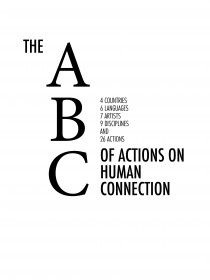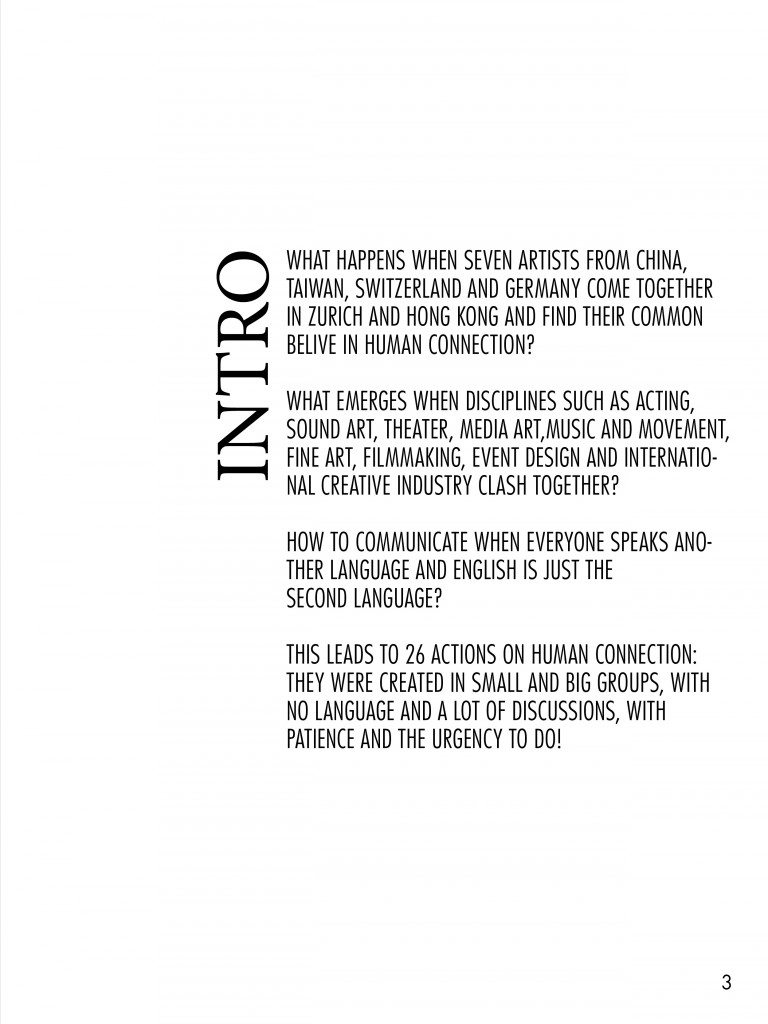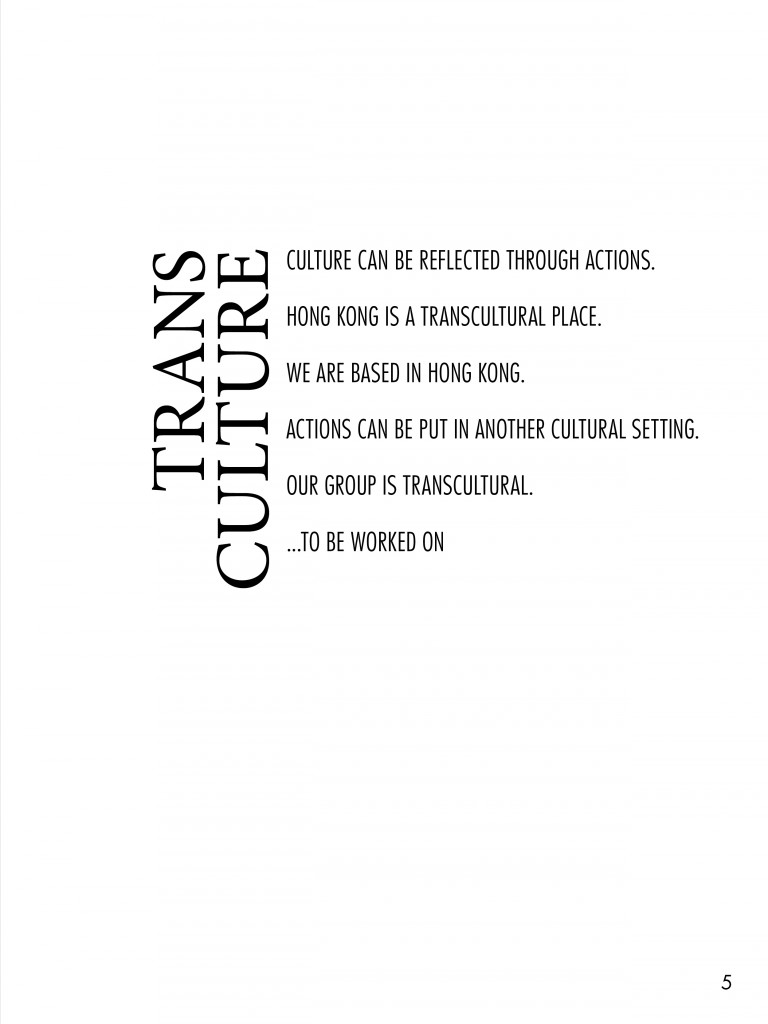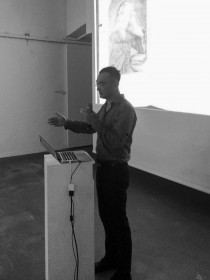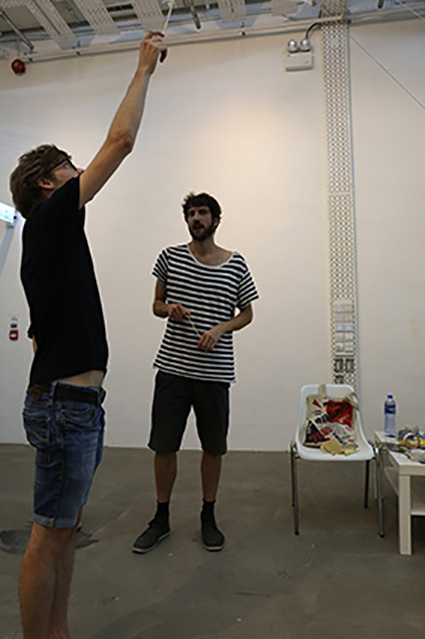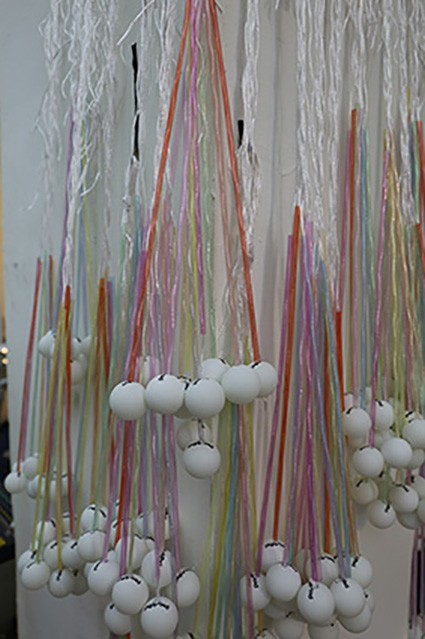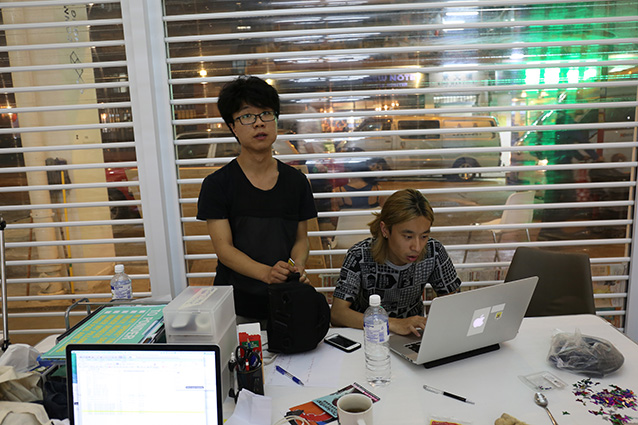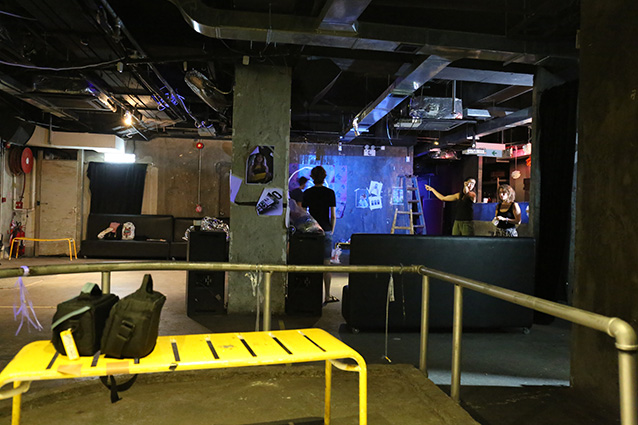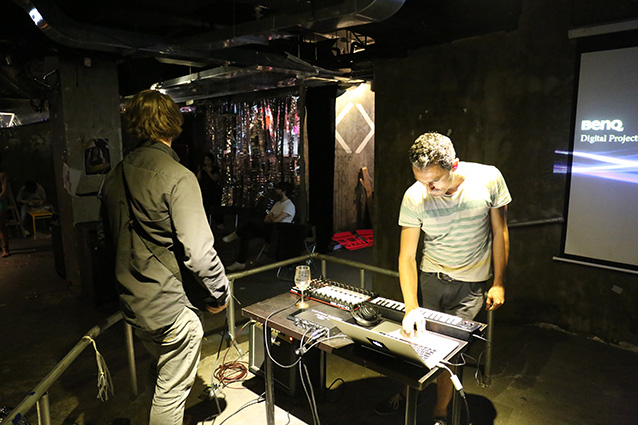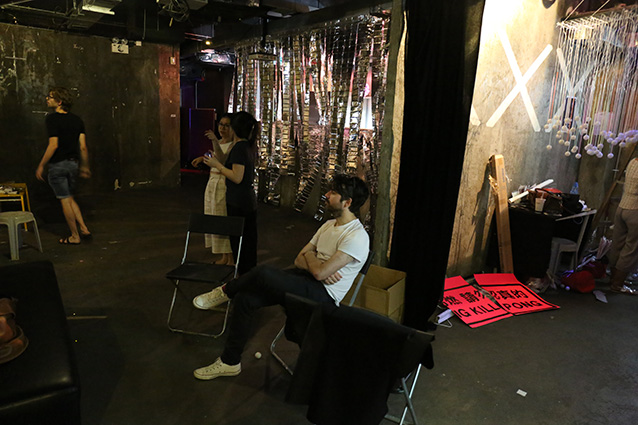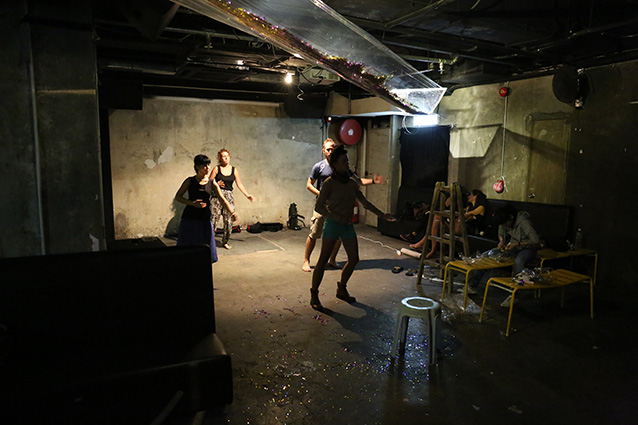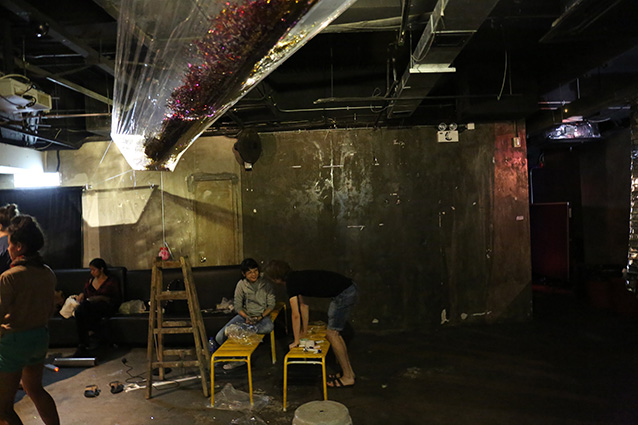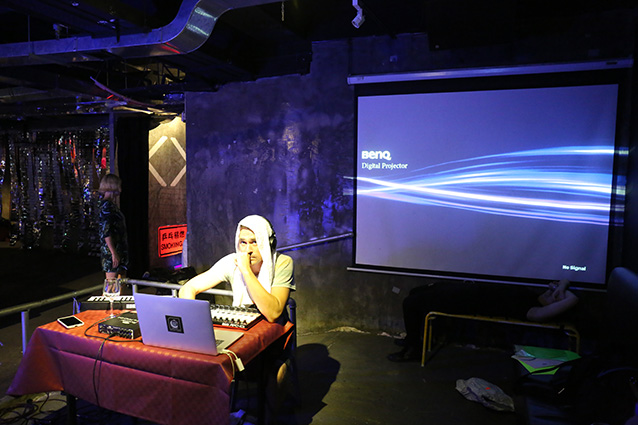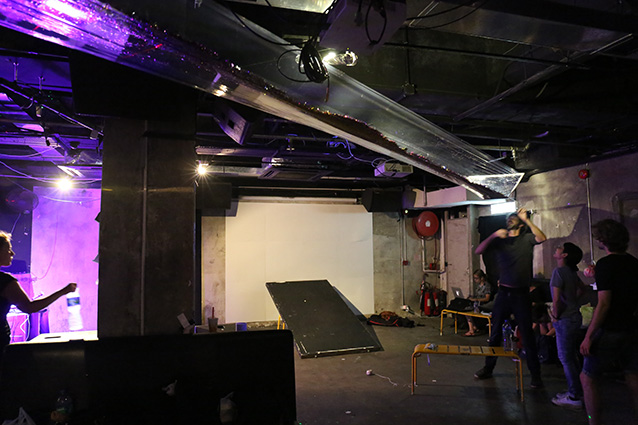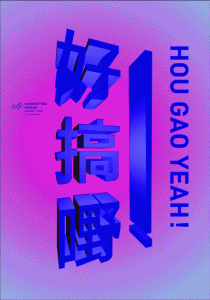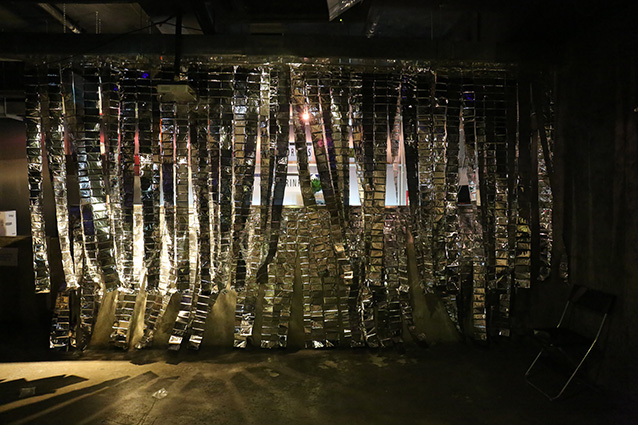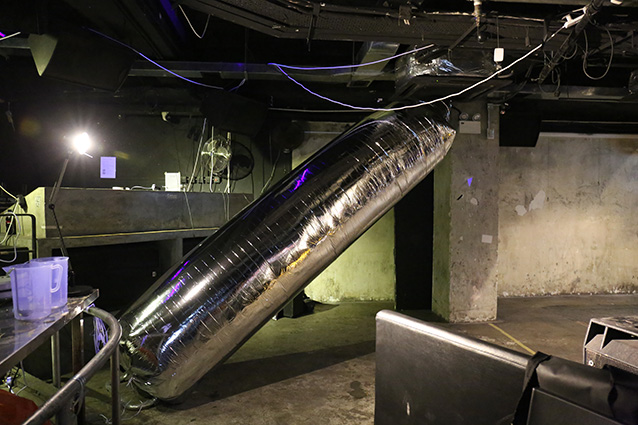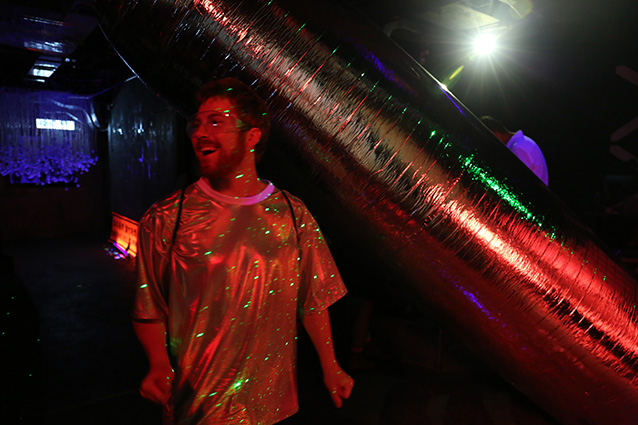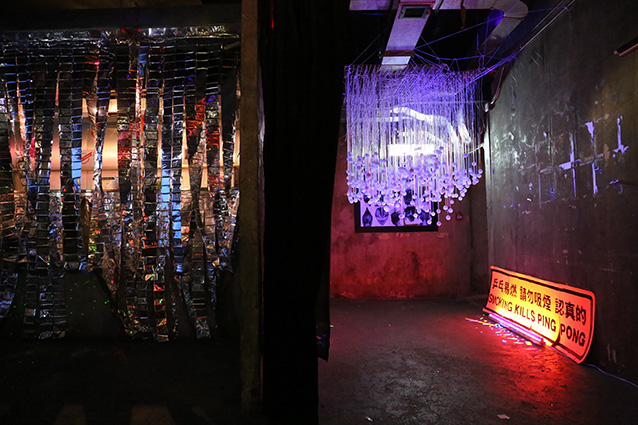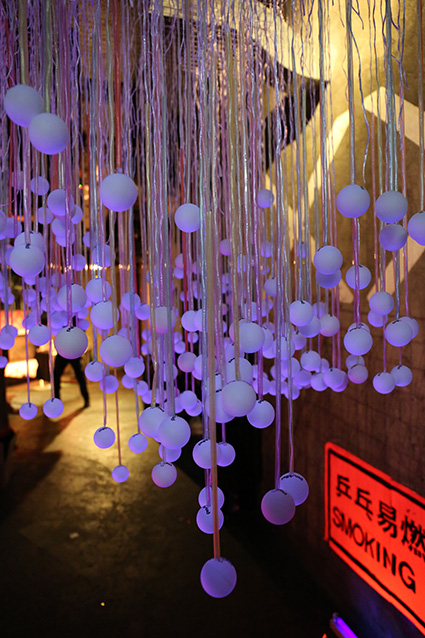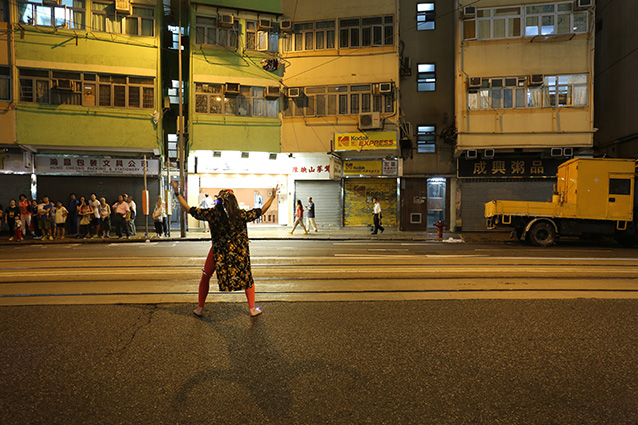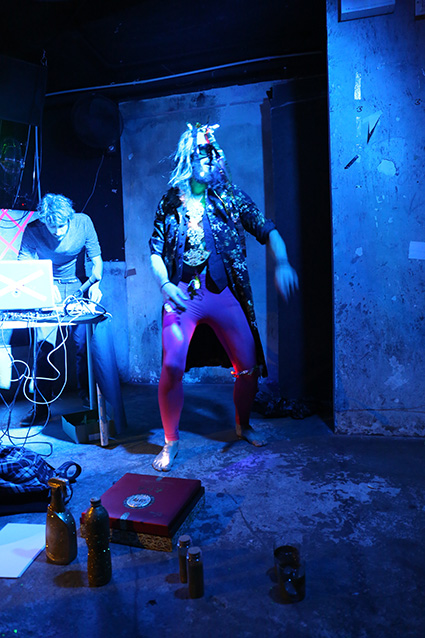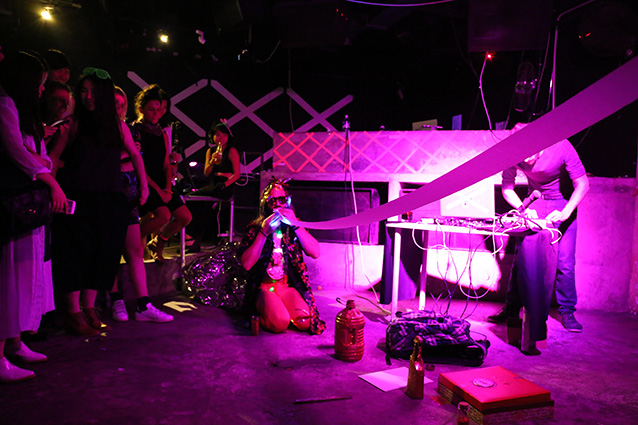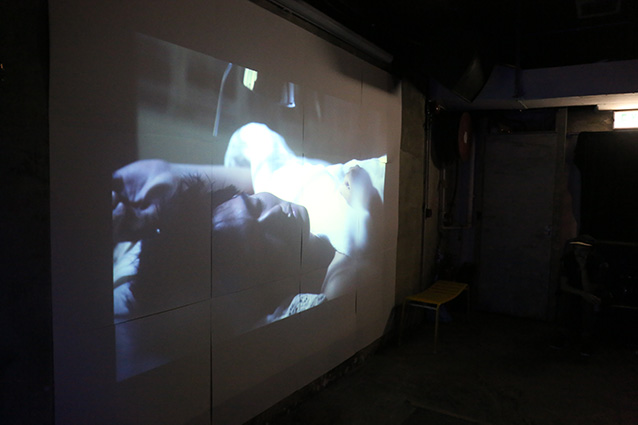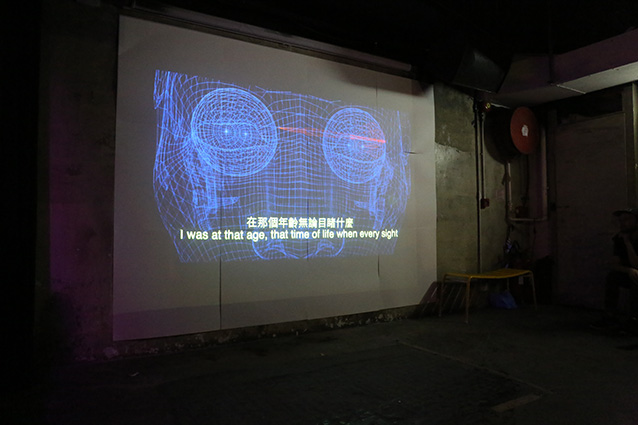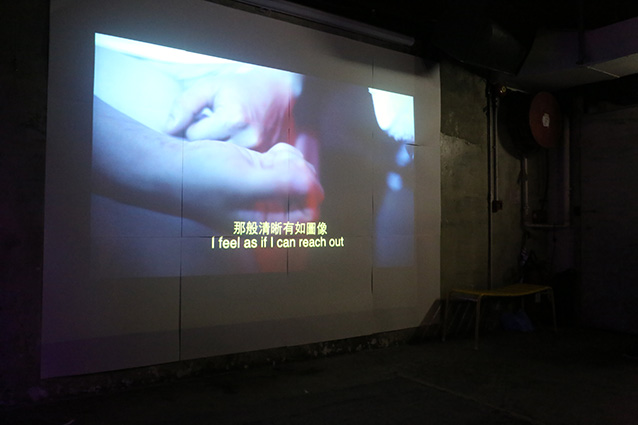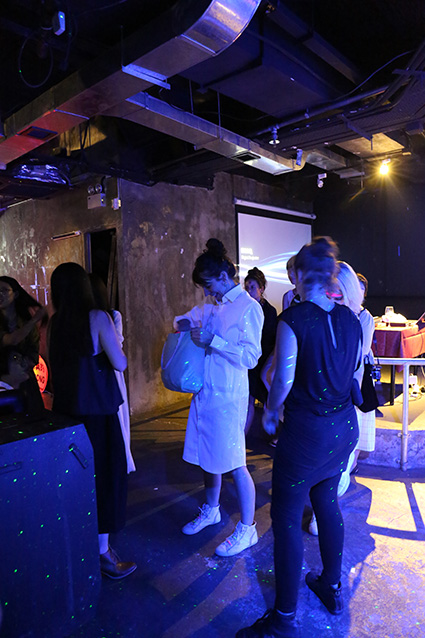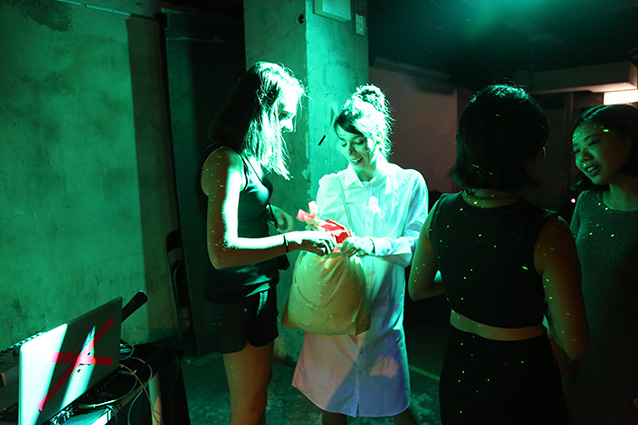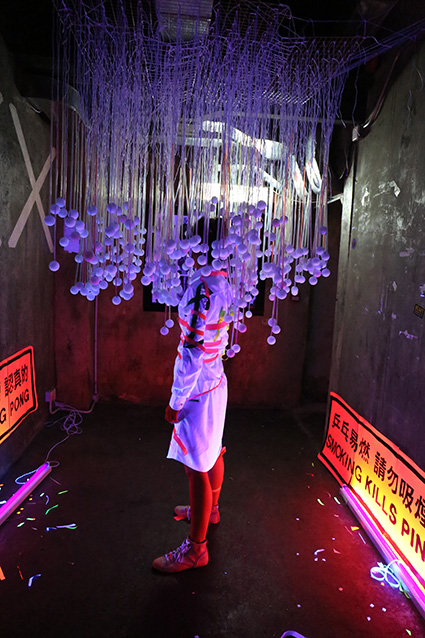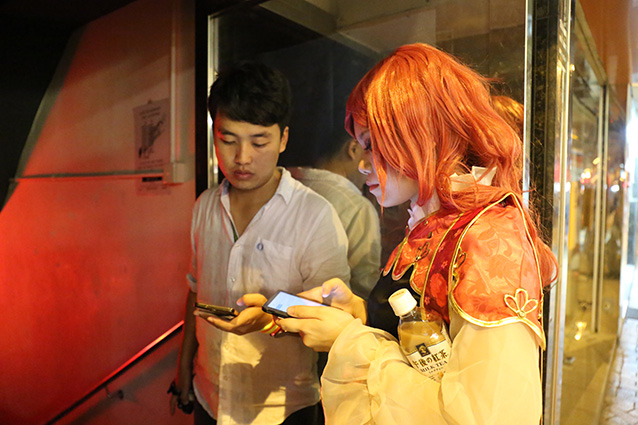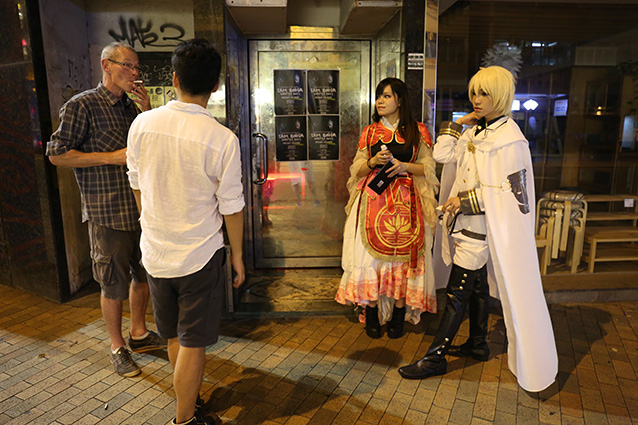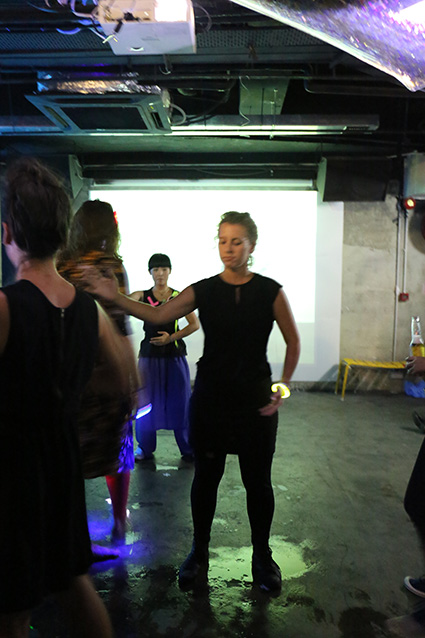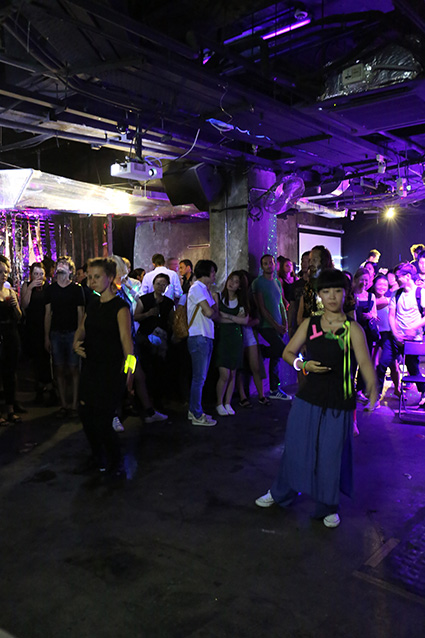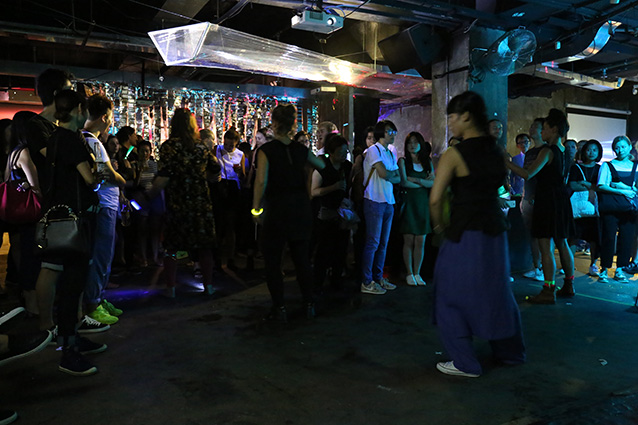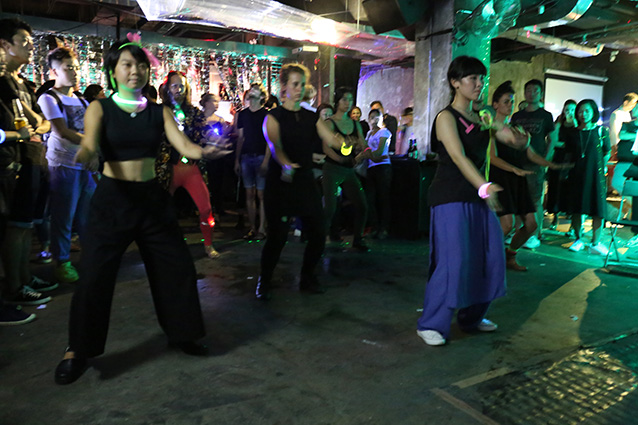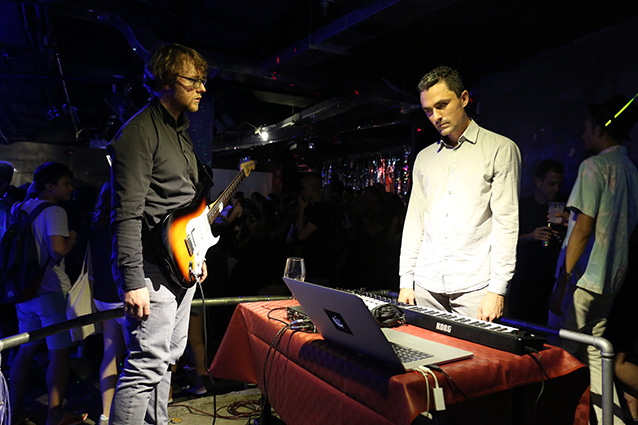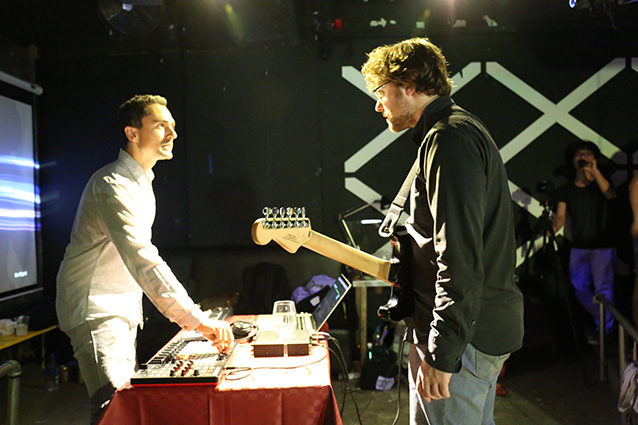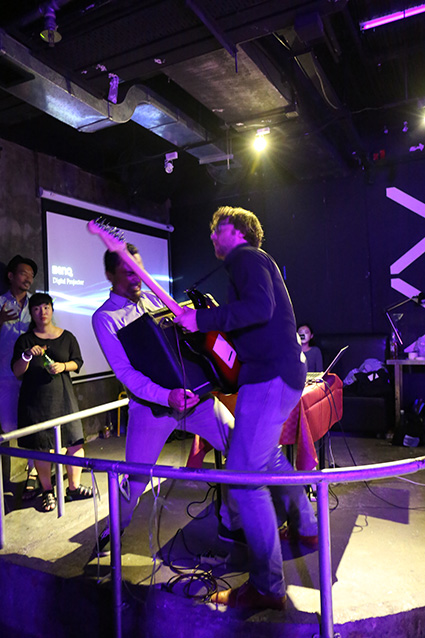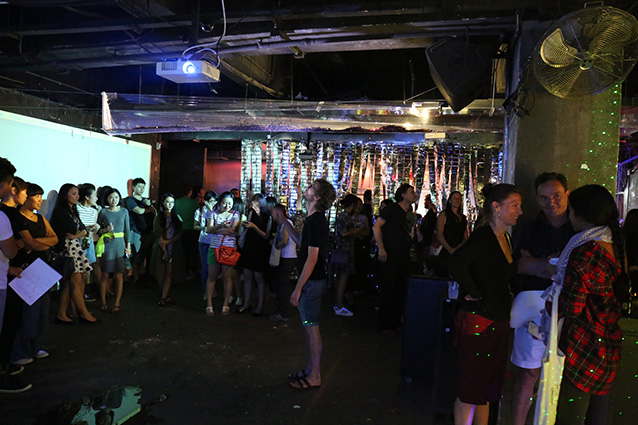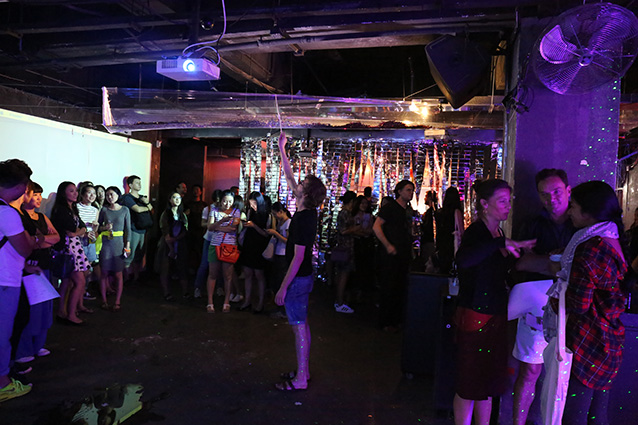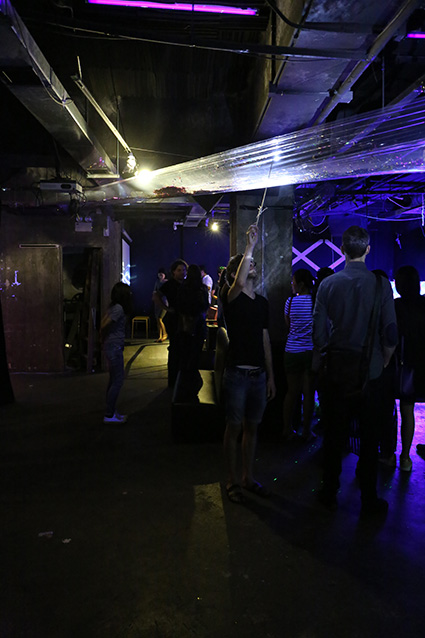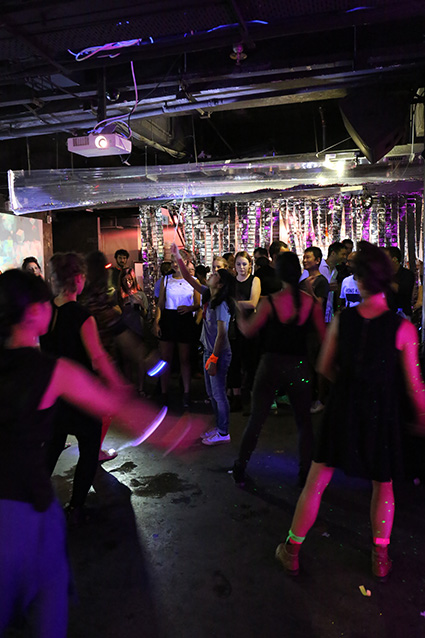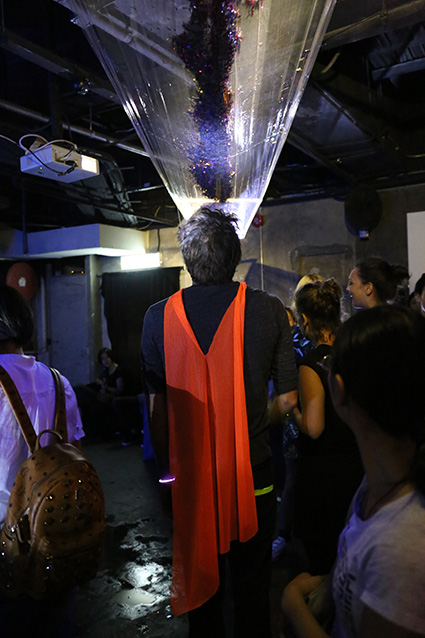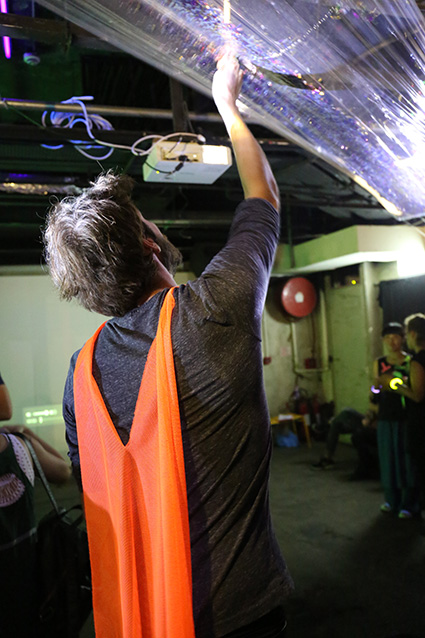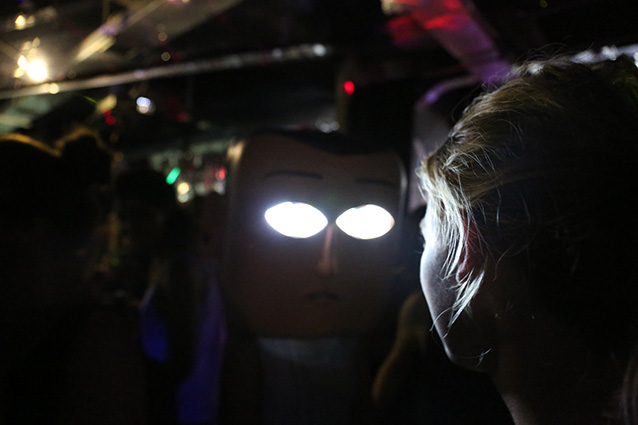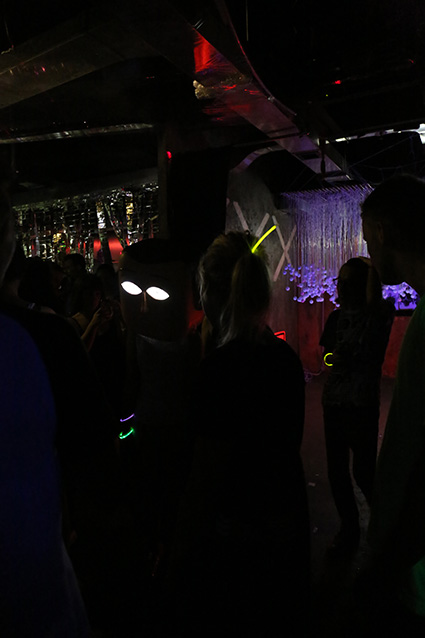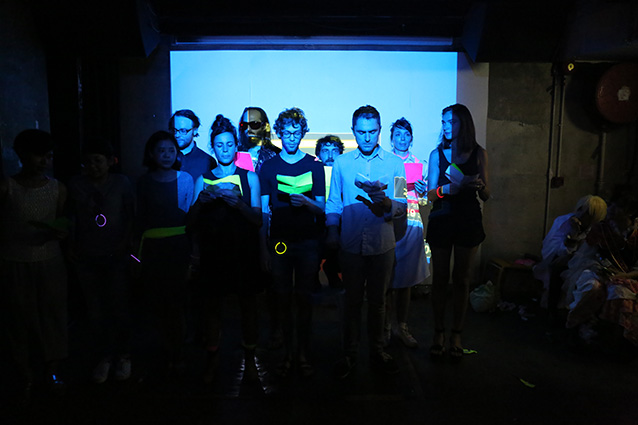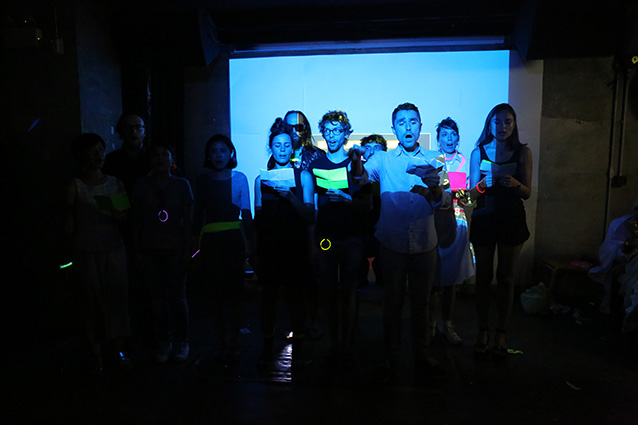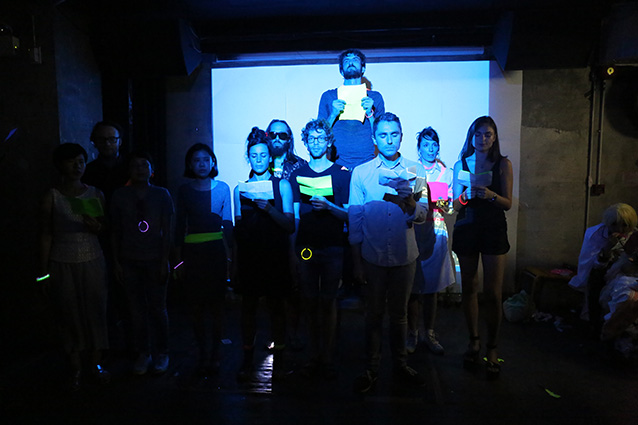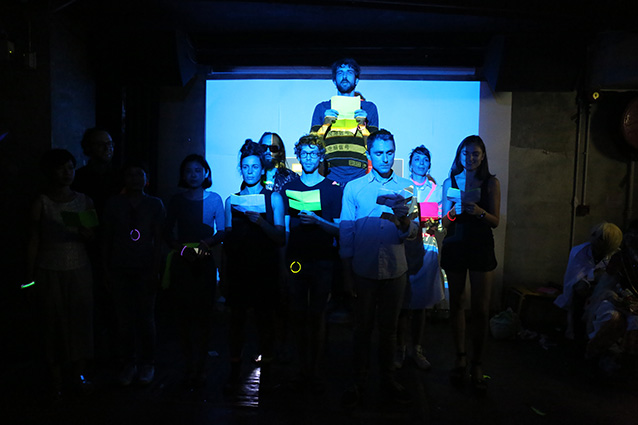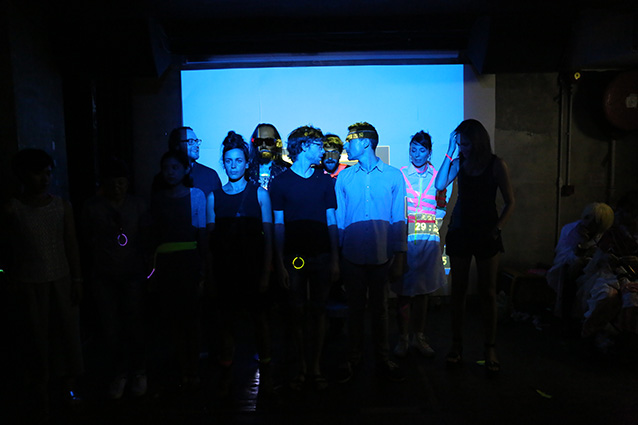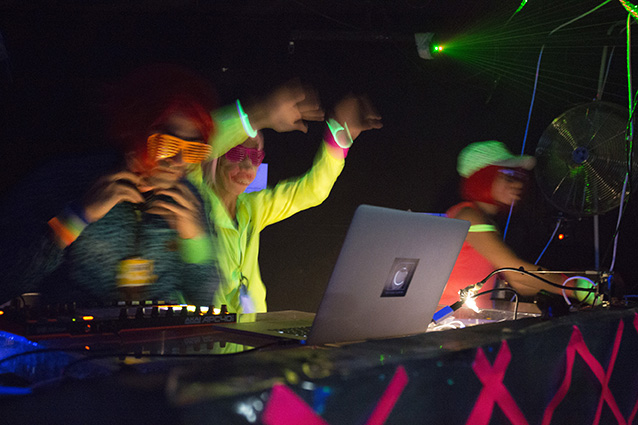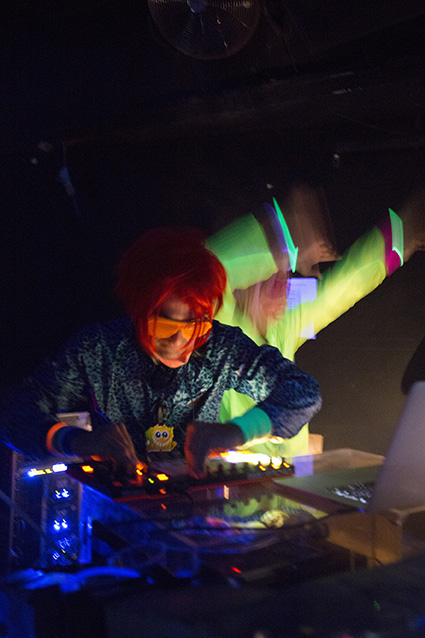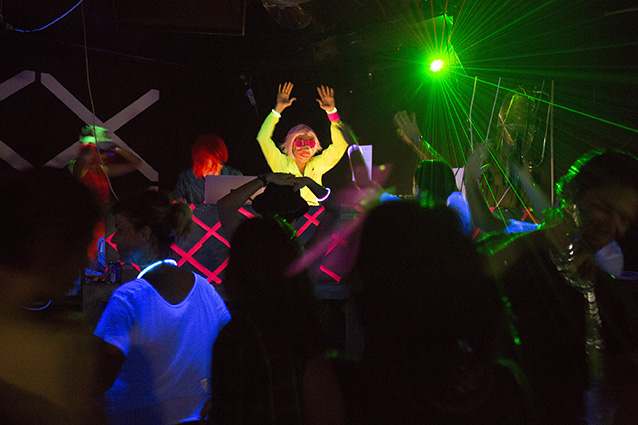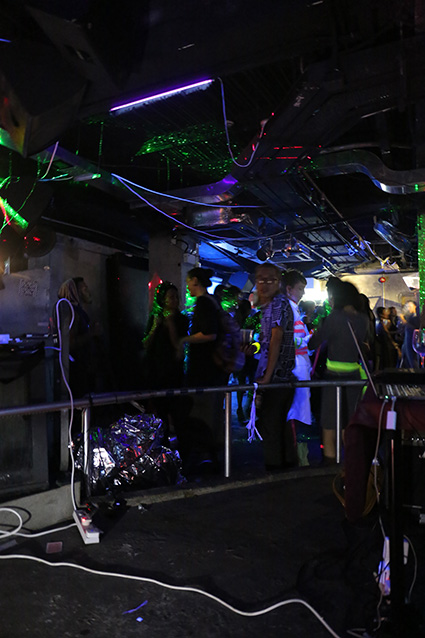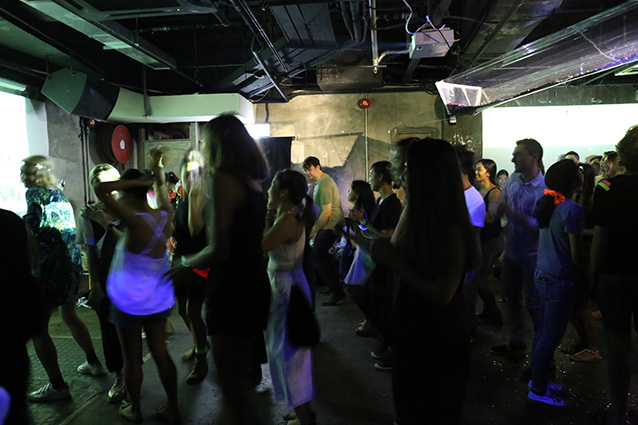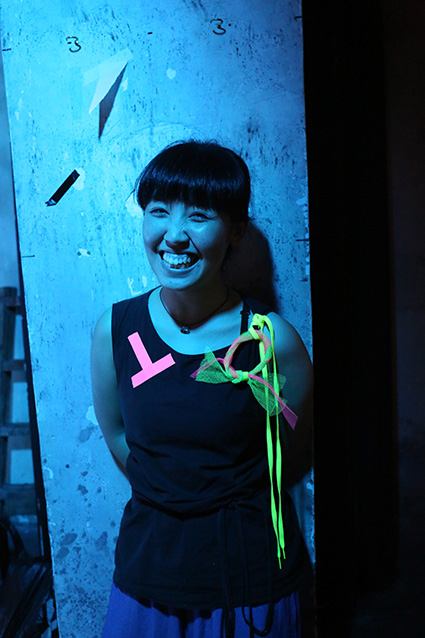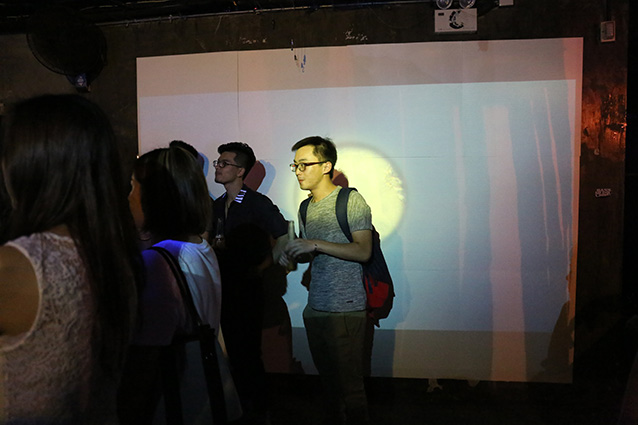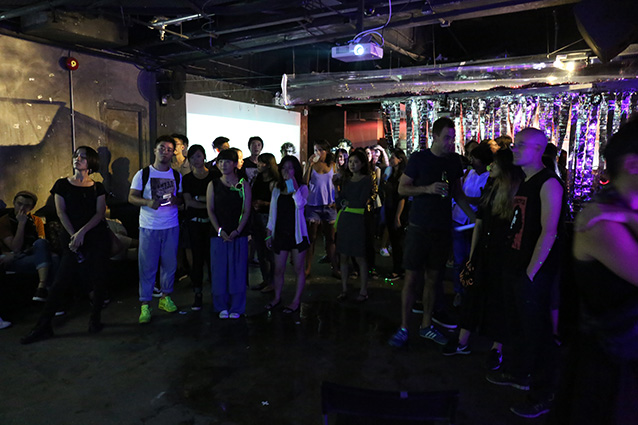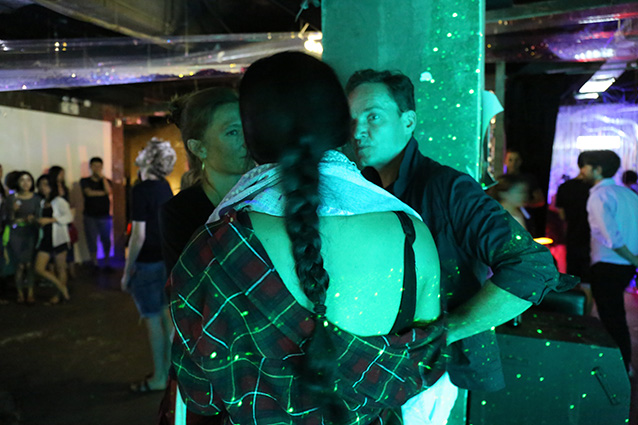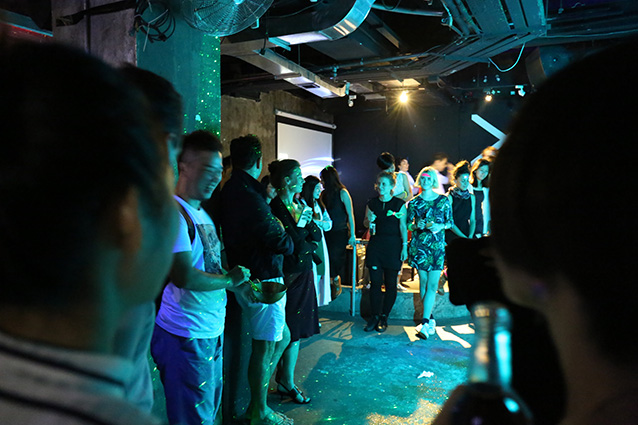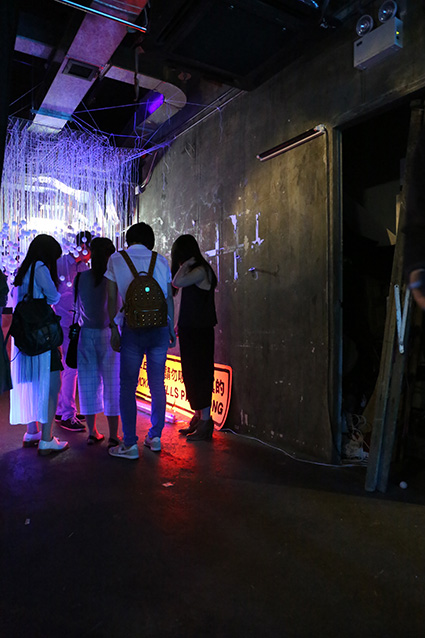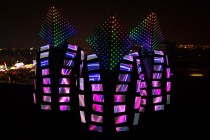Kategorie: Allgemein
Grass Stage’s Route to Social Theatre
Lecture by Zhao Chuan
Writer, art critic, curator and theatre director
„The stage is a small world, and the world is a big stage“- how does reality unveil drama every day and make it impossible for us to stay out of social theatre? Grass Stage is a theatre collective founded in spring 2005. Under the direction of Zhao Chuan—writer, curator and theater director, it has put on a number of programs and performances which steadily grew in influence and acclaim. The members of Grass Stage encourage ordinary persons to enter the theater to create a social theater with a rich social conscience. Grass Stage’s pieces, within a framework of the most basic “poor theater”, use a diverse set of techniques including physical theater, texts, documentary footage, oral story-telling, clown performance and performance art, engendering powerful spaces for intellectual exchange. Over the years it has deployed various venues to stage not-for-profit performances and discussions in China. Their theatre has thus become a gathering spots for all kinds of people, continually creating fluid public spaces. Their post-performance talks have often become the scene of theatre unexpectedly.
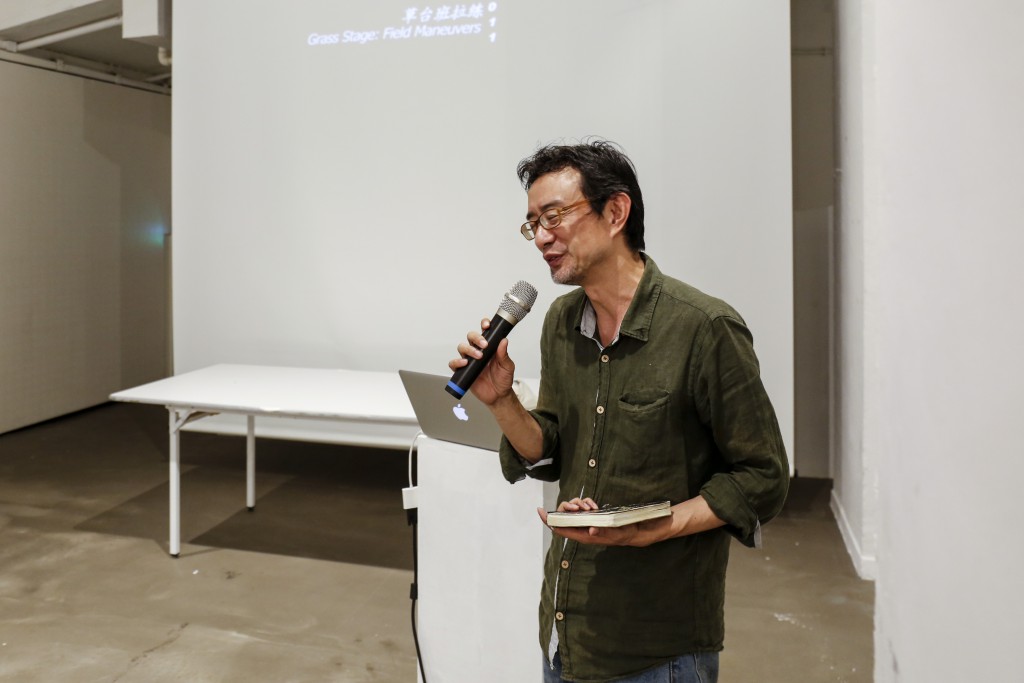
Zhao Chuan is a writer, art critic, curator and theatre director who creates alternative, political theatre in Shanghai. He is the founding member and mastermind of the very important Chinese theatre collective Grass Stage since 2005. His work devoted to the promotion of new social theatre movement and the creation of non-profit public space. The collective has focused on deepening the connection between theatre and society, and has made use of a wide range of venues and situations for performances and discussions. Grass Stage events are not only spaces for bringing together diverse elements of society, but also provide, in a country relatively lacking in opportunities for public participation, a fluid and varied range of public social spaces. His theatre works have been performed in many Chinese cities, as well as in outside of China. Zhao Chuan has been awarded several literature awards, including the Unita Prize for New Novelists (Taiwan 2001). His curatorial projects including 2014 Performance Project at OCAT Shenzhen; “Action Asia” at Shanghai Rockbund Art Museum from 2013 to 2014. He was artistic director for Mecooon Fringe Festival in Shanghai in 2009 and 2010.
Thursday, October 29 – 7pm
Connecting Space Hong Kong
Isabelle Sprenger
work in progress – somewhere in between A to Z
Due to our working method we realized following small projects in the last weeks:
__
Chungking Mansions
The Traders_But: It‘s not so much about the visitors, it‘s more about the other traders.
So we decided to sell something very different from what the traders are selling, and something that is a bit absurd. How do the traders react when we interfere in their space?
In Chungking Mansions you‘ll find many traders. They sell food, electronic gadgets, especially Cellphones, SIM-Cards,… and some other things. The laws inside Chungking Mansions are not so strictly enforced. But are there any informal rules, enforced by the people occupying the space? How do the trader react if you sell something too?
African Man_He was interested. He asked why I think it‘s good to go on the rooftop. He‘s never been on the rooftop. Then he realised that someone was filming the scene. He spoke to him and told him no to film, that this is not nice and that he has to ask before he films. He was getting quite angry. The filmer excused. Then he walked away.
The man leaning on the back of the front desk, from Pakistan
To look and look away. Then look longer and look away. Then longer and longer… I realised it quite quickly, I think. Will he speak to me? How long will he wait? Sometimes he spoke to the men behind me. Then he beckoned me. „Where are you from?“, was the first question. He‘s the owner of some restaurants downstairs. He‘s been in HongKong for 14 years.
People passing by_Most western people took a look on the flyer and then said: “No, thank you“. Most chinese people didn‘t look at the flyer and said nothing. Younger people in general rather tended to look at the flyer and to say No.
The Security Man at the Front Desk in the Entrance Hall_After some minutes right in front of the desk he told me to live. I should go outside. It‘s not allowed to make an advertisement inside. He‘s english was not very good. I tried to explain that I want to sell not to advertise but he did‘t unterstand and pointed the way out quite strongly. So I left.
In General_Chinese people tend rather not to react. But they were mostly people visiting the Mansions and not traders. Pakistani or Indians were mostly curious. A lot of them looked but not all talked. But maybe there also „rules“ (e.g. the Pakistani who was speaking to the other pakistani/indish, but he, „the chief“ startet the talk).
_
How do people show curiosity? Do people with different cultural backgrounds show their curiosity in different ways? Do man and woman show curiosity different? Is it ok to start a conversation just out of curiosity? Do people observe other people? How do they observe? How long can you stare at a person? If you stare too long, is it unfriendly? Why do we think we shouldn‘t stare at people? How do curiosity and human connection match together?
_
__
Afternoon Tea
Frame: It all startet with missunderstandings. The idea was to go for a afternoon tea. But it was not clear for which kind of afternoon tea. British high tea, british afternoon tea, chinese tea, hongkongese tea, local tea? What is local tea? What is local? Who is a local? Nobody of our group.
We finally managed to decide to go to a local as possible tea house in the afternoon, like lot of office workers do as we heard. Most restaurants which serve afternoon teas offer tea set. So we tried to look for a tea set in bustling MongKok.
Are traditional, local tea sets salty or sweet? If it‘s salty, what‘s the differents then with normal lunch? Some of us wanted to eat something sweet, more like desert, because we just had lunch.
Luckily we find a unspectaculare, little restaurant with two tea sets (A and B, A was asian noodle soup, B was western toast) and some sweet pasterys outside!
My thoughts: I really liked how everything startet with the confusion of which kind of afternoon tea we were looking for. To me it was crystal clear to go to a local, HongKong-style afternoon tea in a simple restaurant which offers tea sets. The tea sets would include tea and something salty to eat. That was what I heard about afternoon tea in HongKong. But then there was all these missunderstandings which I really liked, because it has so much to do with transculturality. British, chinese, HongKongese, mixed, sweet, salty, touristy or local…
I liked to observe the people there. There was a group of old woman, a lot of man which were alone , a group of man and us. Far more men than women. And no alone women just alone men. The people who were there on their own were mixed, one was in a suit, always on his phone (I really liked to see him, because he was how I expected it), others were more casual dressed.
We had some interestings discussions during the tea. If HongKong people eat five meals a day, why are they not fat? Is this food healthy? What is healthy food? Is it healthier to cook or to eat outside? How often do you eat in a restaurant? In HongKong it‘s not expensive to eat in simple restaurant, in Switzerland it‘s much cheaper to cook than to eat in a restaurant. But in Switzerland all of us have a well equiped kitchen and enough space to cook, in Hong Kong it‘s different. Do you go in a restaurant on your own? Why do you or why don‘t you? Why to you eat alone in the cafeteria but not in a restaurant? Do you go alone for a coffee? For a beer?
Personally, it depresses me to eat alone, in a restaurant, but also at home. I mostly eat together with other people. Eating is something social to me. I like to listen to others while eating, to tell them about my day or my presents thoughts and to have discussions.
__
Words in your ears, words in your eyes
The idea is simple.
Three european people record each three words in their mother tongue, and write a text about the reasons why they chose specially these three words. Three chinese people listen at these words, choose some of them, and write a text where they let their imagination go about the possible meaning of these words, the story that could be behind.
Three chinese people write each three chinese characters, and write a text about the reasons why they chose specially these three characters. Three european people look at these characters, choose some of them, and write a text where they let their imagination go about the meaning of these characters, the story than could be behind.
During an exhibition where all the texts are presented – the texts are translated in english – these six people discover together the results of this game, and the bridges that imagination can build between two persons, with the help of one word, or of one character.
The recorded words were play during the exhibition.
An experiment as the beginning of a reflexion about languages, about imagination, and about human connection.
Conception : Nicolas Müller
Realisation : Nicolas Müller and Shang-Chiao Li
Exhibition : Thursday 8th and Friday 9th October, Connecting Space, Hong Kong
Transcription of the text above :
Schlärpälä (schlaerpaelae)
Slowly walking. With a lack of body-tension. The asians in the MTR are “ schlärpälä“, but not with coziness. More with a hecticness, as if 5 seconds of waiting at the entrance would really make a difference. But maybe this is the best way of walking in this city. Not too stressed, and still not being relaxed.
„Schlärpälä“ in asian style.
__
Therefore we made a brainstorming on a shared drive, what human connections means to us/ where it can happen / what it can be about.. We still have to discuss this ABC, but we use it as to see the wide, the perspectives on human connection of the other group members and a word in the list can also be used as a starting/ end point for actions on human connection. 
Anonymity and Creativity
Lecture by Christopher Kriese
What would you do if you knew nobody was watching? What
would you do if you were invisible in the real world? What
would you do if you were invisible in the internet? How could
anonymity transform arts and activism?
This is an experimental short lecutre. please send feedback to: kriese@posteo.de
Tracing Hong Kong Urban Space in the 1950s through the Cinema
Lecturer by Kenneth Ip Shu Kei
Chair School of Film and Television HKAPA
There were two kinds of cinema in Hong Kong in the 1950s, the Cantonese cinema which catered more to the grass-root population, and the Mandarin cinema which found its audience mostly among the middle class. Both cinemas serve as a mirror to the many social problems facing the colony after WWII. The lecture attempts to look at the division of urban space, particularly the housing problem, in that decade via a few outstanding and representative cinematic works.
Shu Kei began writing scripts for television when he was still studying in the University of Hong Kong. Among the directors he worked with during this period were Ann HUI, Partrick TAM, YIM Ho , Allen FONG and TSUI Hark. He entered Golden Harvest Film Company after graduation as scriptwriter and assistant director. In 1980, he wrote the script for John WOO’s TO HELL WITH THE DEVIL. In 1981, he made his directorial debut, SEALED WITH A KISS. Since then, he has directed six drama features, including HU-DU-MEN (1996) and A QUEER STORY (1997) and a documentary, SUNLESS DAYS which won a Jury Award at the Rimini Film Festival and a Special Award at the Berlin Film Festival. He’s also a distributor specialising in art-house films. Up to date, the library of his distribution company has over 200 titles. Besides these, he is responsible for the world marketing and distribution of such important Chinese films as TIAN Zhuangzhuang’s THE BLUE KITE, CHEN Kaige’s FAREWELL TO MY CONCUBINE, WONG Kar-wai’s ASHES OF TIME and CHUNGKING EXPRESS. He is the producer of ZHANG Yuan’s BEIJING BASTARDS and Fruit CHAN’s MADE IN HONG KONG, among others.
He has edited and published several anthologies of yearly film reviews for the Hong Kong Film Critics Society, two books on the Hong Kong Cinema in the Fifties and Sixties for the Hong Kong International Film Festival and is the author of two novels.
Thursday, October 15 – 7pm
Connecting Space Hong Kong
Zi Yan Lan
[ab]sense
The delicate dribble of water on the cheek,
The remnant smell of espresso,
*PAK* – snapping chopsticks,
and the lingering taste of orange citrus.
These are the sensations of the ordinary. If life gives us a tabula rasa, sensations are our tools. Sensations are perceivable by all of us, though often neglected. With a certain consciousness, we can bring these sensations to our awareness. To be reminded of the humbling existence of our kind.
To feel sensations.
To react to these feelings.
To feel the feelings.
Inspired by the somatosensory experience, we play with the most mundane objects of every life. We activate our senses. We discover new ways to sense and be sensed. We explore the absence and presence of sensations. They come in waves, changing as frequently as our perceptions of them. One by one, we help each other through a somatosensory journey that he or she will remember for a lifetime.
Our video serves as an expression of these very experiences. The production enabled us to think about our sensations from a different perspective. By examining methodically and in detail the effects of these sensorial inputs, we created a structure that translated the sensations into form.
To reveal the sensations.
To reflect these feelings.
To reveal the feelings.
by Haijiao Ma, Tobias Fandel, Philipp Taugenichts, Liane Mah
Self questions (Ida):
1. How do we place ourselves in HK?
I am a stranger but also familiar with the city, because part of my family is living there. I find myself inbetween being a foreigner and a visitor, a guest.
Dreams and emotions are mostly always the same for people all over the world. But the way they are expressed is totally different and these distinctions, no matter how tiny, are something that interest me a lot.
2. How do I connect with other people?
I like to observe people and look at them for a while. How do they behave? What clothes do they wear? How do they talk with other people?
The way people live tells me a lot about their character.
What kind of furniture do they have? Do they have paintings on their walls? Are they clean, messy or super organised?
From the moment I meet a person I try to connect with them and collect as much information about them as possible.
A lot of this process happens automatically, it is like an implemented system, like a computer program: I scan other people. I do not always like that, but nobody can free himself from this process. Everybody takes decisions through and due to his cultural, biographical and ethnical knowledge.
3. What kind of people do we want to connect to?
As many diverse people as possible who make their living in Hong Kong: on the range ofdishwasher to millionaire. The contrast in HK is really big.
4. What does it mean to me to be in HK?
On the one hand it is familiar, because this is my second trip to Hong Kong and a part of my family is from HK. I experience HK from their perspective and it feels familiar in that way. But I also feel the differences of being a European in HK.
If I leave the door and exit the `European compound` I become a stranger, because I do not understand the language and a lot of things that I see, I experience them differently than things that I know and I am used to. But I enjoy this situation a lot, because my senses are much more open. I feel like a child, seeing, smelling things for the first time.Through this situation of being a stranger I am confronted with my own perception, my values and my limitations. I see myself mirrored in other people that I pass on the street.
Hong Kong is a melting pot of different cultures and contrasts: mainland chinese people/Hong Kong residents, nature versus mega city, rich/poor, educated/no school knowledge, sea/land, up up up-a city of diversity of every kind.
5. What is feels strange and different for you in Hong Kong?
Sometimes I feel strange, because I am stranger in HK. The people here look and behavedifferent and that already creates a distance.
In chinese culture and in Hong Kong a lot of things work in another way. For example for me as a vegetarian it is really strange that nearly every animal can be a meal like turtles, snakes, dogs and ducks etc.
Some people look at me and my daughter as if we are from an other planet. Others do not care, I become one of them. I find that quite interesting, because I can become an alien inbetween all the people. It is a strange feeling to stand out with ones appearance . And on the other hand sometimes being just one of million other people.
6. Do you miss your homeland?
At the moment I do not, because I am also not living in my home country Germany. Living in Switzerland I am also a foreigner. I only miss some family and friends, in my case people define home for me.
7. What does `homeland` mean to you?
My homeland is where I grew up. Germany feels familiar to me, I know the people, culture and rules. But there are other very interesting places in the world which can be familiar as well. Home is what we make out of it.
8. How do you work as an artist?
Be open, see, observe, take time, leave space for experiments. Trust your senses, be brave, risk something and stay who you are. Connect yourself with people, never try to solve every problem only by yourself. Ask for advice if necessary and let yourself go. Inspiration needs time, to dare to go deeper. Question yourself. Be patient!
9. What are your dreams ?
I live for the moment and I try to be modest with my wishes and dreams. It is my personal secret!
Non-essentialist hybridization – Now you see me, now you don’t.
Lecture by Frank Vigneron
Director of MA program in Fine Art, Chinese University of Hong Kong
After a recapitulation of the notions of ‘‘East’’ and ‘‘West’’ in the work of Edward Said and the kind of problems they have generated in the evaluation of art in Hong Kong (illustrated with some examples of two kinds of artwork using concepts and visuals from Euro-America and China), the process of hybridization is then presented as the way in which a culture will transform into something new. The question is therefore to establish what can be called a hybrid. To put it simply, one calls ‘‘hybrid’’ in the cultural realm something that does not yet look ‘‘native.’’ For instance, in present-day China what was still considered to be a hybrid in the arts not so long ago is often identified as more Chinese than ‘‘Western’’ today. A cultural element only stays a hybrid as long as it is seen as such, but its visibility is subject to change. This begs another question: what are the conditions of the visibility of hybridity and through what process does it go before being identified as something ‘‘native’’? Hybridity is in reality a very unstable characteristic, and its presence depends very much on who is looking and how; it is a question of cultural representation and, as a result, cannot be inherent in the object itself. This non-essentialist view of hybridization in the visual arts, presenting itself in the shape of the Deleuzian rhizome, may shed a different light on questions related to differences and similarities between cultures.
Thursday, October 08 – 7pm
Connecting Space Hong Kong
Group Manual to ‚The ABC of Actions on Human Connection‘
First we probably talked more about our group than about what we want to do. Because we are the big group, we always had to work on how we organize our group. We found a possible working format in ‚The ABC of Actions on Human Connection‘. The Idea is to realize 26 little actions which focus on what we all have as common ground: The believe in human connection.
To work on the 26 actions for the next 6 weeks, we developed following group manual:
____
GROUP MANUAL
..(to be tested & refined in Eggtion)..
Theme
We all believe in human connection; this is what we want to focus on; it is our main theme.
Presentation Thursday
Goal of the group: to make a presentation about the work in progress before, during (in case it is not disturbing or it’s achieving something artistically), or after the lecture. The presentation is a composition of all works made by during the week. The composition of the presentation is decided in the afternoon by all members.The presentation can be any kind of presentation format; the form of the presentation reflects, lights up, questions … the content(s). To present something is an obligation for all groups that compose our group; to present something successful or interesting is optional.
Each group collects and writes down opinions of persons who took part in the presentation; the participants transmit faithfully these opinions to the group. To avoid any drama, each group collect the opinions about the work of another group.
Friday
Feed-back of the participants about the thursdays presentation. Transmission of the collected opinions of the others to the group. Discussion about the need or the will to follow up these ideas.
Then: Each member brings in new themes, new topics, new ideas, new starting points or a new word to work on; this has to be as concrete as possible.
Propositions
The desires of the participants have to follow and constitute the aim of any proposition. The propositions are made for all group members, each responsible can ask for the number of participants She/He wants. Each member decides to participate in at least one project.
Project
The total number of projects for a week can be between 1 and 52. The number of projects decide the number of groups.
Group Size
The group consists of 7 artists. The working group size can range from 2 to 7 people; it depends on the need for the group and the interest in the project.
Time
The time period to work on the projects take place between Friday afternoon and the next Thursday morning. All the members of the group announce their absences for the work period.
Time Schedule
A time schedule is established for the period between Friday afternoon and the next Thursday afternoon; each group has time to work.
Friday afternoon to
Thursday morning
Working in the group(s).
____
by Fabian Gutscher, Larissa Holaschke, Shang-Chiao Lin, Siyuan Liu, Nicolas Müller, Isabelle Sprenger and Hey Wu
Imaginary Identity: The Fake Formosan George Psalmanaazaar
Lecture by Lin Hongjohn
Curator and Chairperson of Fine Arts Dep, Taipei National University of the Arts, Taiwan
In 1703 the high society of London there appeared George Psalmanaazaar who claimed himself a Formosan to be abducted by a Christian missionary. In his book, An Historical and Geographical Description of Formosa(1704) , described Formosa to be a country of abundant resources, governed by a Japanese ruler. In this fictive book, Formosan people was almost half-naked, only wearing silver plates over their private parts. Horses, camels, and elephants were domesticated for transportation. One of the high peaks of the book was that every year Formosans sacrificed the eldest sons to their gods, and even in the second edition (1705), Formosan were exaggerated as cannibals, who ate those were sacrificed and executed. Being a celebrity of his exotic oriental identity and feted by all the literary and philosophical lions of London, Psalmanaazaar were even invited to teach Formosan in Oxford University. Psalmanaazaar was the beau monde in the celebrities of London.
Psalmanaazaar’s real identity is still unknown today, as much as in his will he still signed with the fictional Taiwanese name. In order to portray as a Formosan, he ate raw meat with various heavy spices. He even lighted candle when he slept to pass for the other that he was actually reading, for Formosans, according to his book, learned knowledge through their sleeps. For 18th century occidental world Ilha Formosa, Taiwan, represents one of the most distant country they can imagine not just geographically but symbolically as well.
Since 2008, I have been working on this fake Taiwanese under the title The Museum of George Psalmanazzare, MOGP exhibiting in Rotterdam, Manchester, Shanghai and Taipei. In the 2012 Taipei Biennial as participated artist, the project was presented in a manner much similar to that of museum. I link the secrete path between identity and the politics of fantasy, and the other, the real of the local, much as a missing part that is intrinsic to the real Taiwanese. In combining the seemingly impossible fragments of sights and sounds, to link the web of identity politics that linger between the ancient and the contemporary, the truth and falsity to capture the fleeting moment of the perverse, the primitive, the empowered to glance the phantom of history.
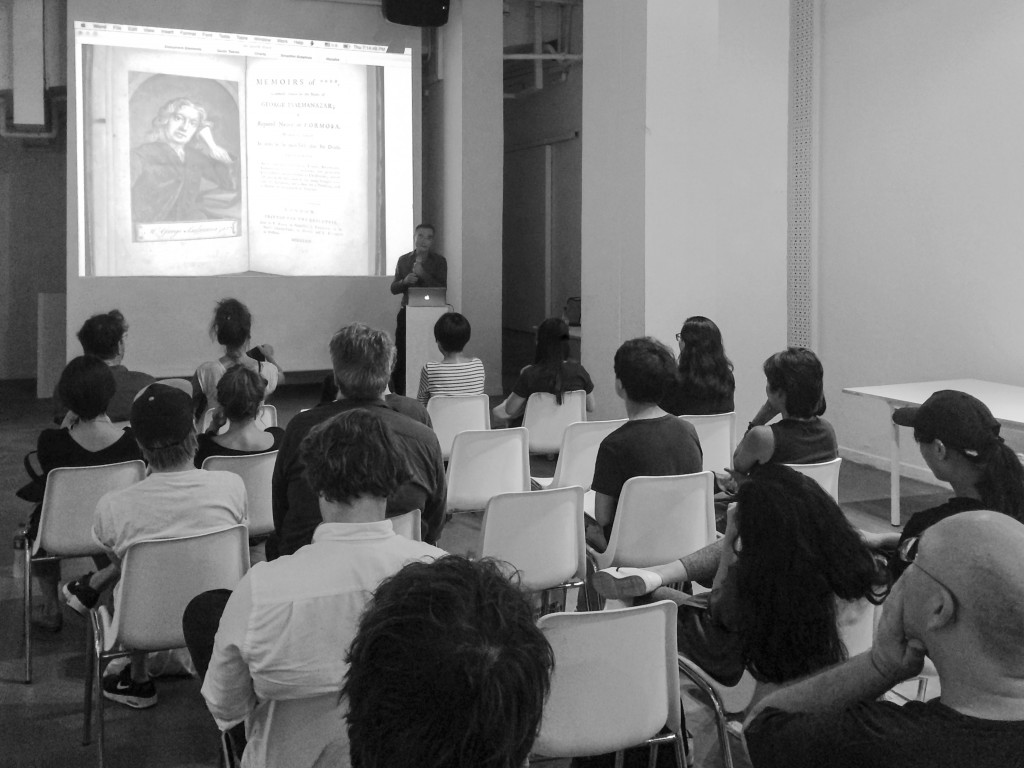
Thursday, October 01 – 7pm
Connecting Space Hong Kong
Making of HOU GAO YEAH! 好搞嘢!
Transcultural Collaboration 2015
New Graduate-Level Educational Format in the Arts based in Hong Kong:
Transcultural Collaboration 2015
A project of Zurich University of the Arts, Hong Kong Academy for Performing Arts, City University of Hong Kong/School of Creative Media, China Academy of Art/School of Intermedia Art/Hangzhou and Taipei National University of the Arts
In 2015 we are launching a pioneering transcultural and cross-disciplinary educational format called “Transcultural Collaboration” for graduate students of all art and design disciplines. Selected students from the involved partner institutions will have the possibility to study for one semester within this specific program, which will be based mainly in Hong Kong.
General Content „Transcultural Collaboration“
The basis of the project is the need for a discussion and understanding of “globalization” and its emerging questions and issues. It is obvious that globalization is not only about expanding production, consumption and communication, but also implies the problems and potentials of differentiation and distinction, of provoking otherness, of different forms of cultural evolution and blending, or of influencing power structures.
The programme has two central characteristics that can only be experienced and explored in this very specific setting. First of all it will focus on topics of transculturality as the key content that includes subjects like traditions, identity, genealogy of the present, values, ethics, different forms of life or globalization specifically between Europe and South East Asia. Given their sensitivity to social and cultural conditions, and their ability to formulate and express a variety of topics with aesthetic means, artistic and design practices can make an ideal contribution to transcultural discourse. Participants will acquire profound competences, which are more and more in demand working in international contexts, learning about the other and being able to reflect one’s own culture. Hong Kong is predestined as an exemplary location within this thematic context.
Secondly practical cross-disciplinary collaboration between cultures and art forms is the second important focus of the programme and its principal working method. This approach will promote intensive exchange and first-hand experience of the transcultural topics as well as further differentiate and extend one’s own discipline. Theoretical inputs will help participants to critically reflect on transculturality and to gain further insights into this pressing issue.
Curriculum
On the background of the transcultural and cross-disciplinary focus three main phases define the basic structure of the semester: The starting phase is dedicated to questions of “self-awareness”, as well as the introduction of the specific interests of the participating students and lecturers that will highly influence the semester content. Based on that the constitution of mixed groups and their topics will be the starting point for the practical cross-disciplinary work and the development art and design projects involving the range of disciplines and competences of the group members. Followed by a second phase that is dedicated to the topic of “collaboration” thus questions of how we collaborate and position ourselves related to our culture, traditions, society, art, other disciplines or a business environment. The third phase called “trans public” where we focus on questions of art and design production and reception. While the practical character of the three main phases is central it will be strongly connected to theoretical inputs and reflection in the fields of Asian and European (historical and contemporary) culture, issues of transculturality, art and design practice and cultural management in various formats like lectures, panels, literature, workshops or mentoring. Between the three main parts of the semester programme there will be two inserts where one will be a two weeks excursion in Europe or Asia as well as a specific workshop lead by renowned artists.
Further Education and Exchange of Faculty
The transcultural and cross-disciplinary context also puts the lecturers in the position of “learners” in this programme. Like the participating students, lecturers will also be required to expose themselves to transcultural issues, to engage in critical self-reflection, and to work in cross-cultural and cross-disciplinary teams. In association with the students, lecturers will be largely responsible for developing the concrete contents, methods, and attitudes of the individual semester. In this manner, they will gain first-hand experience and knowledge of transcultural and cross-disciplinary learning environments that they can apply and implement at their home institutions afterwards.
Field of Excellence and Global Network
Through the innovative focus on questions of transculturality and cross-disciplinary practice we are building up a leading international centre of excellence in these fields which will help to extend the global network of the involved partners, lecturers and students and contribute substantially to the reflection and discussion of current problems.
Partners
Main Partners
Zurich University of the Arts (ZHdK)
Hong Kong Academy for Performing Arts (HKAPA)
City University of Hong Kong/School of Creative Media (CityU/SCM)
China Academy of Art/School of Intermedia Art, Hangzhou (CAA/SIMA)
Additional Partners
Taipei National University of the Arts, Taiwan (TNUA)
Tokyo University of the Arts, Dep. of Fine Arts
Hong Kong Baptist University, Academy of Visual Arts (HKBU/AVA)
Supported by
Mercator Foundation Switzerland

Participating Students “Transcultural Collaboration 2015”
Fabian Gutscher, MA Transdisciplinarity, ZHdK – Larissa Holaschke, MA Design/FoE Event, ZHdK – Isabelle Sprenger, MA Music Pedagogy, ZHdK – Nina Willimann, MA Transdisciplinarity, ZHdK – Philipp Spillmann, MA Publishing Studies, ZHdK – Ana-Maria Negrea, MA Theatre/Scenography, ZHdK – Benjamin Ryser, MA Contemporary Music, ZHdK – Simon Dietersdorfer, MA Composition for Film, Media, Theatre, ZHdK – Nicolas Müller, MA Theatre/Acting, ZHdK – Tobias Fandel, MA Transdisciplinarity, ZHdK – Ida Sons, MA Art Education, ZHdK – Lan Ziyan, MA Intermedia Art, China Academy of Art (CAA), Hangzhou – Li Chaoran, MA Intermedia Art, CAA, Hangzhou – Ma Haijiao, MA Intermedia Art, CAA, Hangzhou – Liu Xiaobin, MA Fine Arts in Creative Media, HK City University, School of Creative Media (SCM) – Wong Ka Chung, MA Fine Arts in Creative Media, HK City University, SCM
Participating Lecturers/Guests “Transcultural Collaboration 2015”
Responsible Project Coordinators/Lecturers
Daniel Späti, Head of Transcultural Collaboration, ZHdK – Zheng Bo, Assistant Professor, CityU/School of Creative Media, HK – Shi Ke, Associate Professor, China Academy of Art, Hangzhou – Jim McGowan, Senior Lecturer (Sound), MFA Coordinator TEA, HK Academy for Performing Arts
Lecturers
Heinrich Lüber, Artist, Head of MA Art Education ZHdK – Kingsley Ng, Artist/Designer, HK Baptist University – Florian Dombois, Artist/Researcher/Lecturer, ZHdK
Hongjohn Lin, Chair Fine Arts Dep. and Transdisciplinary Studies, TNUA – Jörg Scheller, Curator/Theorist, Head of BA Photography, ZHdK – Nuria Krämer, Head of Connecting Space HK, ZHdK – Stephen Cheung, Head of Graduate Education Centre, HKAPA –
Hayat Erdogan, Dramaturgist/Theorist, ZHdK – Matthias Ziegler, Musician/Lecturer ZHdK – Patrick Müller, Head of Connecting Spaces HK-ZH, Head of MA Transdisciplinary Studies ZHdK – various additional lecturers SCM, CAA, HKAPA,…
Assistants
Christopher Kriese, Director, Assistant BA Directing ZHdK
Katja Gläss, Artist/Photographer, Assistant MA Transdisciplinary Studies ZHdK
Andrea Roca, Designer/Curator, Associate researcher Design Departement ZHdK
External Guests
Zhao Chuan, Director/Author, Shanghai – Eisa Jocson, Dancer/Choreographer, Manila- Björn Beneditz, Artist and Member of German pop band “Deichkind”, Hamburg –
Xiaolu Guo, Novelist/Film Director, China – Jay Forster, Art Director, Clockenflap Festival HK – Andalus, Cultural Activist, Zurich…more to be confirmed
Contact
Daniel Späti
Head of Transcultural Collaboration
daniel.spaeti@zhdk.ch
CH: +41 79 432 81 03
HK: +852 6239 3079
Patrick Müller
Head of Connecting Spaces Hong Kong – Zurich
patrick.mueller@zhdk.ch
Connecting Spaces Hong Kong – Zurich
At Zurich University of the Arts “Transcultural Collaboration” is part of “Connecting Spaces Hong Kong – Zurich” which is the initiator of this new program. Under the project title “Connecting Spaces Hong Kong – Zurich” ZHdK is seeking to establish a study centre in Hong Kong in collaboration with other art universities from Hong Kong, China and Southeast Asia. One key objective of the envisaged centre is to explore perspectives for how a 21st-century arts university might advance as an institution in a globalized world. Conneting Space Hong Kong, a physical space in North Point, not only serves as a workshop space, but also as a stage for production (exhibitions, performances, …). With its character of an art space it produces productive links to the public and to the art scene, a lab for exchange on different levels of the involved cultures. Within “Connecting Spaces Hong Kong – Zurich” the graduate-level semester program is a key initiative in building up an innovative educational format and starting a long-term collaboration between the partners.
***Appendix:
Declaration “Transcultural Collaboration”
For the following reasons we are convinced that an education and dispute about transcultural issues is essential for contemporary art and design students to be prepared for their future professional life:
• A global frame is nowadays a basic condition of all art and design work
• Artists and designers are mobile and acting globally both for production and for presentation. Art and design are shown, debated and consumed in an international context (market, exhibitions, publications, internet,..)
• Accordingly the challenge is to position and manifest oneself in different political, social, economical and cultural contexts. This applies for all world regions as the fragmentation in centres and peripheries has become obsolete.
• Therefore learning and producing art and design is not only defined by specific professional expertise, but requires a skilful orientation in the diversity of global cultures and societies (not as supplementary, but as a basic requirement).
• In practice this orientation affects aspects and questions of economy (international finance,..), politics (democracy, human rights, resistance, imperialism, east-west conflicts, trikont,..), technology (virtuality, technology and nature,..) or religions (ethics, philosophy, secularisation,…).
• This complex dispositive of actual artistic and design work asks for a specialisation in art and design education with regard to transcultural topics. It needs time as well as a concept to debate and study these questions. It is not enough to just live, consume, communicate and act globally!
• Contemporary art is transcultural art nowadays. Artist and designers cannot escape from this fact, there are no sheltered or domestic environments anymore.
Therefore we are about to develop a new educational format, which is understood as a format of excellency and specialisation that is oriented along these requirements of a “present future”. It opens the chance and possibility to distinguished students of all art and design disciplines to obtain competencies, advanced skills and a certificate in this field.
HOU GAO YEAH! 好搞嘢!
|
Come and drift with us through a space of experimentation on 26 September in XXX club. Immerse in a party night with performances. Artists from Hong Kong, Mainland, Taiwan, Japan and Europe in collaborative action with live music, dj’s, performances, visuals, installations and interactions. Saturday, 26 September 2015 星期六,9月26號,2015 9.30pm – 4.00am Venue: XXX Gallery B/F, 353-363 Des Voeux Road West, Sai Wan, Hong Kong 德輔道西353-363號, 西環, 香港 DJs: Calvin Ho (AtomicAttack! / UGLY / Robot) Mike the unstoppable (Robot) Jay Pelmet (Robot), DJ TOPICal Island (Glühwurst Records) _________________________________________________________ CURTAIN AND INFLATABLE, Installations by Larissa Holaschke and Isabelle Sprenger _________________________________________________________ PING PONG, Installation in the entrance of XXX by Shang-Chiao Li, Yingch Lin, Jiaru Wu, Ka Chung Wong _________________________________________________________ Chaos Priest, Performance Nicolas Müller with music by Fabian Gutscher _________________________________________________________ Titel Video projections (2 canal,color,sound) by Haijiao Ma, Ziyan Lan _________________________________________________________ Titel, Performance by Ida Sons _________________________________________________________ Titel, Performance by Siyuan Liu _________________________________________________________ Tai-Chi Intervention, dance performance by Yingch Lin, Isabelle Sprenger, Liane Mah, Nicolas Müller, Eisa Jocson, Nina Willimann _________________________________________________________ Finger, music performance by Simon Dietersdorfer, Tobias Fandel _________________________________________________________ Title, Performance by Mayumi Arai, Fabian Gutscher, Benjamin Ryser _________________________________________________________ Titel, Installation-Performance by Jiaru Wu _________________________________________________________
Oh Control is everything Music: Simon Dietersdorfer Choir: Oh control is the everything. Everything can be controlled.
Solist: The city is control. It’s a jungle. It would be jungle. But humans build a city.
Choir: Oh control is everything.
Solist: There would be sea. There would be trees. But there are banks now. The money tries the sea.
Choir: Everything can be controlled.
Solist: Noise of the air conditioning. Trying hard to make this humid place try. Try to stop the walls from crying.
Choir: Don’t you cry. Don’t you feel. Do. Work. Make a living.
Solist: Ask the gods for help. Burn some paper money. Get try. Hold the handrail. Don’t walk. Stand firm. Let the passenger get out first. Don’t eat or drink. Don’t think.
Choir: Oh control is everything.
Solist: Take your mobil. Keep your eyes on the screen. The exit is on the left side. Stand still. Thanks for making me so pretty, my botox. There is no space. There is no place to rest. Work hard. Party hard. Don’t let anything in your body. Protect your self. Don’t smoke.
Choir: Everything can be controlled.
Solist: There are trees. They are dangerous. Buy. Buy now. A rolex. A lexus or a bubblebath? Make some art. Produce good art.
Choir: Make some art. Produce good art.
Solist: There’s a way. Culture is to be defined. Masses must be handled. Optimize. Study. Study harder. Smile. Smilie, funny bunny. Goldfish. Bonsai Tree. Moon Cake.
Guru: Shall I tell you your fortune? Don’t lend money around 54. Good life.
Choir: Oh control is the everything. Everything can be controlled.
_________________________________________________________ DJ TOPICal Island (Glühwurst Records) with Ana-Maria Negrea, Xiaobin Liu _________________________________________________________ Party impressions Artists: Mayumi Arai, Björn Beneditz, Simon Dietersdorfer, Tobias Fandel, Fabian Gutscher, Larissa Holaschke, Eisa Jocson, Nuria Krämer, Ziyan Lan, Chaoran Li, Shang-Chiao Li, Yingchi Lin, Siyuan Liu, Xiaobin Liu, Haijiao Ma, Liane Mah, Nicolas Müller, Ana-Maria Negrea, Andrea Roca, Benjamin Ryser, Ida Sons, Daniel Späti, Philipp Spillmann, Isabelle Sprenger, Nina Willimann, Ka Chung Wong and Jiaru Wu This event is part of the transcultural and cross-disciplinary graduate semester program called „Transcultural Collaboration“ initiated by the Zurich University of the Arts in cooperation with various art universities from Hong Kong, Mainland China, Taiwan and Japan. This semester program takes place in Hong Kong as part of the transcultural collaboration platform Connecting Spaces Hong Kong – Zurich (for more information visit our web site: www.connectingspaces.ch) Main Partners of the Transcultural Collaboration Program Zurich University of the Arts (ZHdK) Hong Kong Academy for Performing Arts (HKAPA) City University of Hong Kong/School of Creative Media (SCM) China Academy of Art/School of Intermedia Arts, Hangzhou/China Additional Partners of the Transcultural Collaboration Program Taipei National University of the Arts, Taiwan Hong Kong Baptist University, Academy of Visual Arts Tokyo University of the Arts, Dep. of Fine Arts Supported by: Mercator Foundation Switzerland |
Lecture Björn Beneditz – Deichkind
Deichkind is one of the most successful German hip-hop collectives. They have created a very unique hip-hop language and stage appearance and celebrate very consequently a particular approach, where they use elements of improvisation, overstatement and appropriation. Björn Beneditz one of the scenographic directors showed us their artistic process from 2000 till today and gave us an impression on the bands artistic strategies.
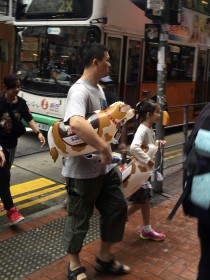
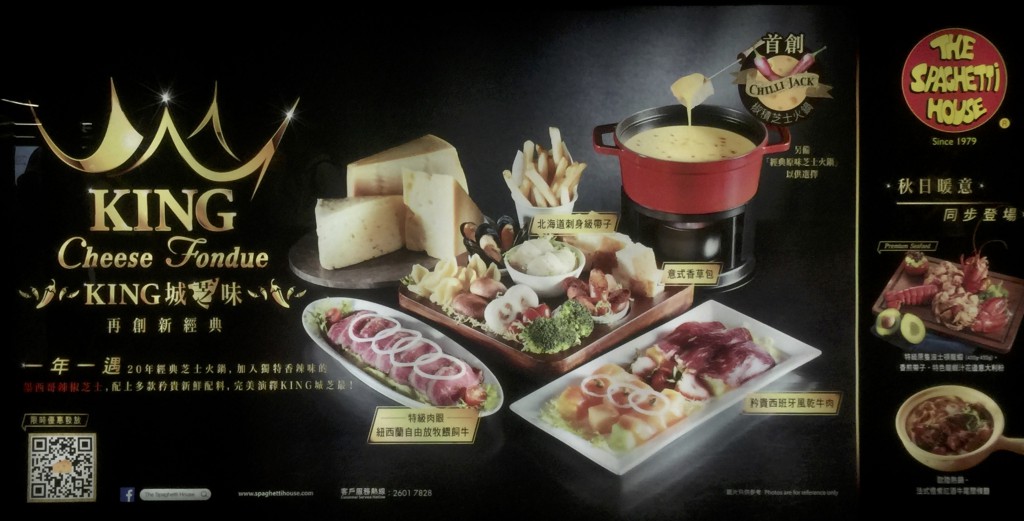
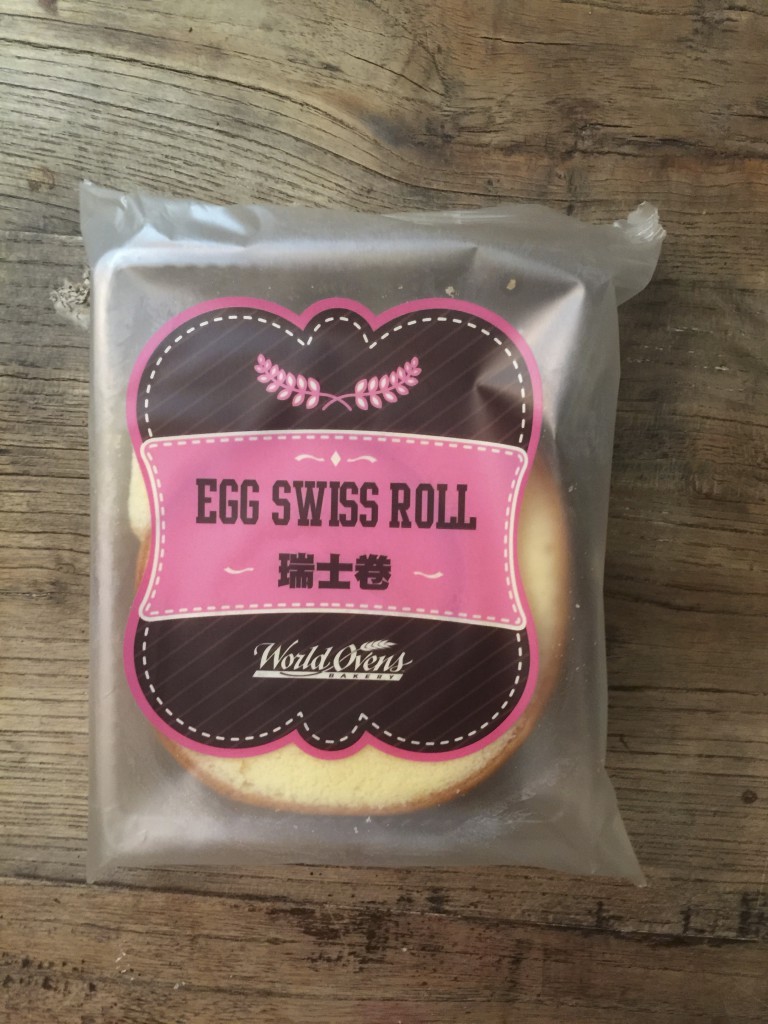
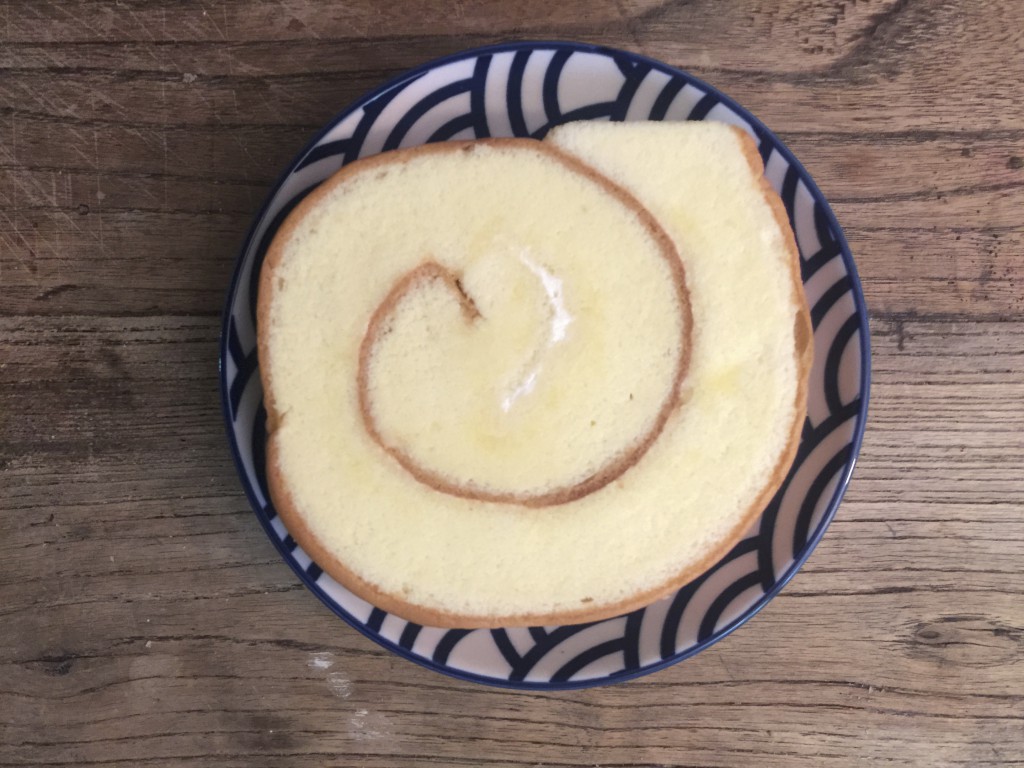
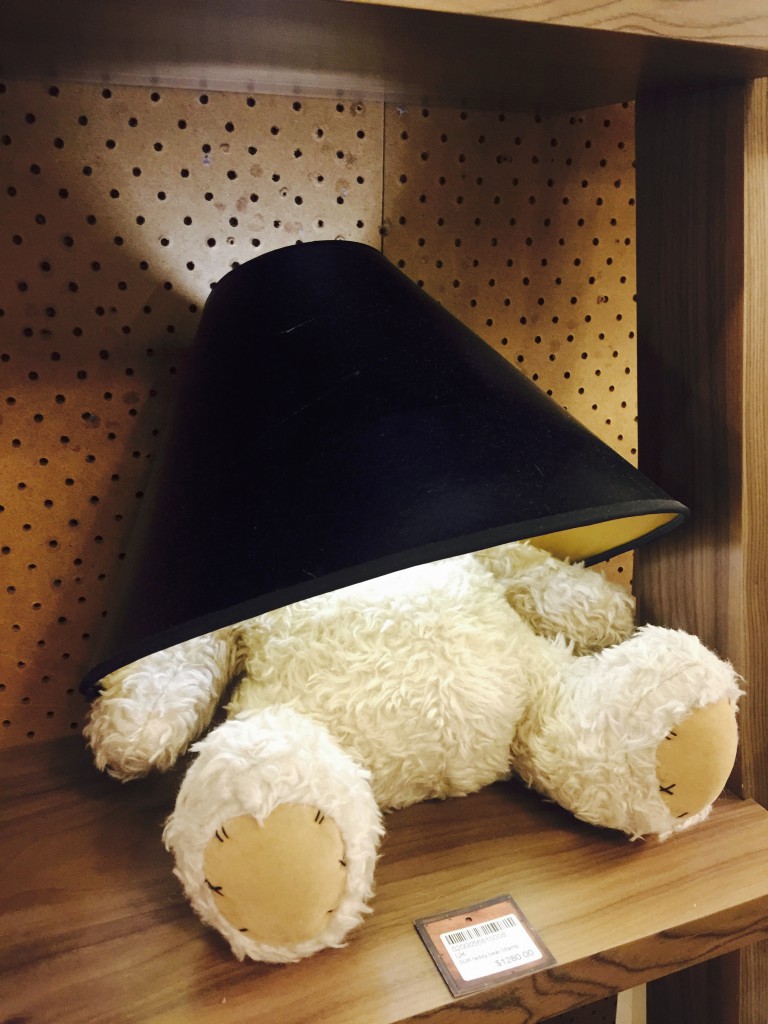
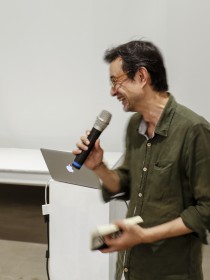
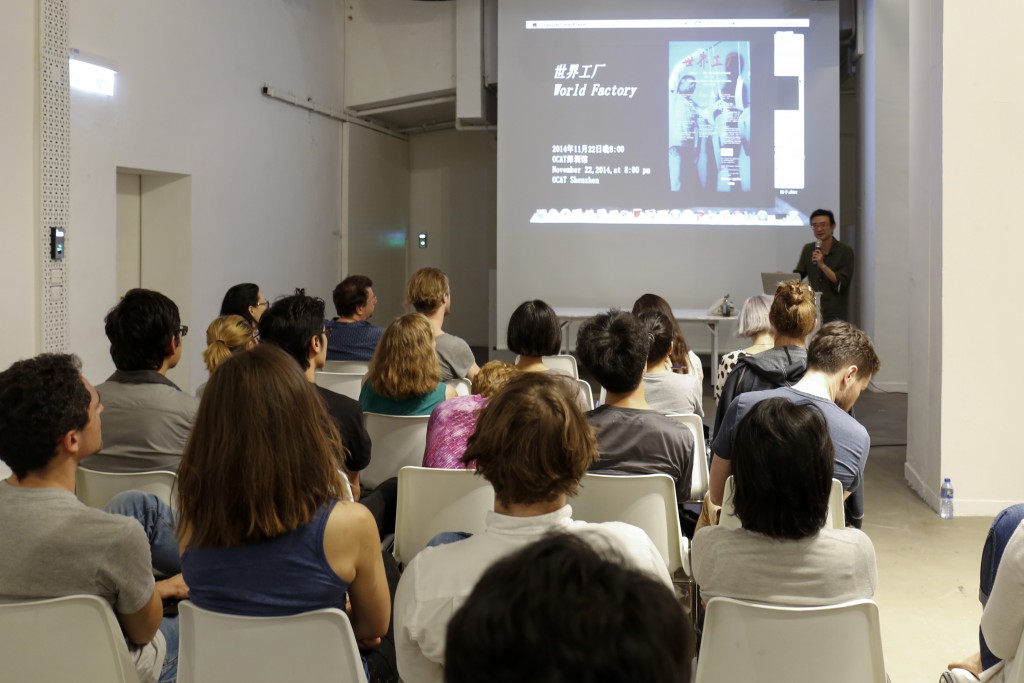
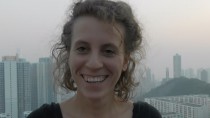
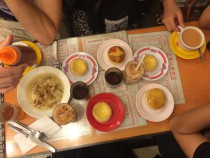
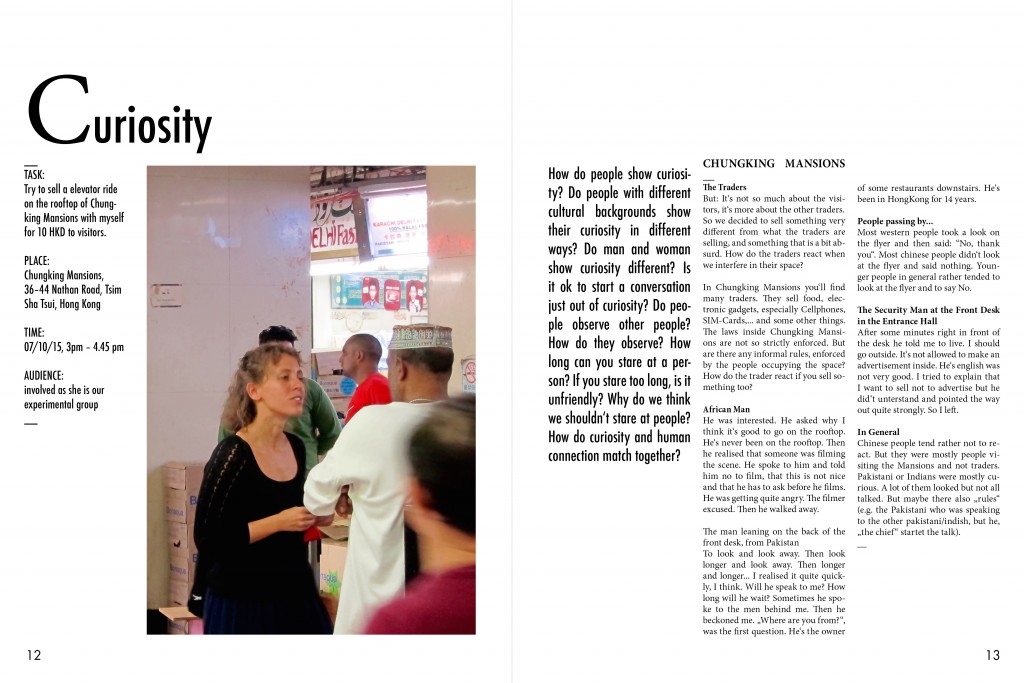
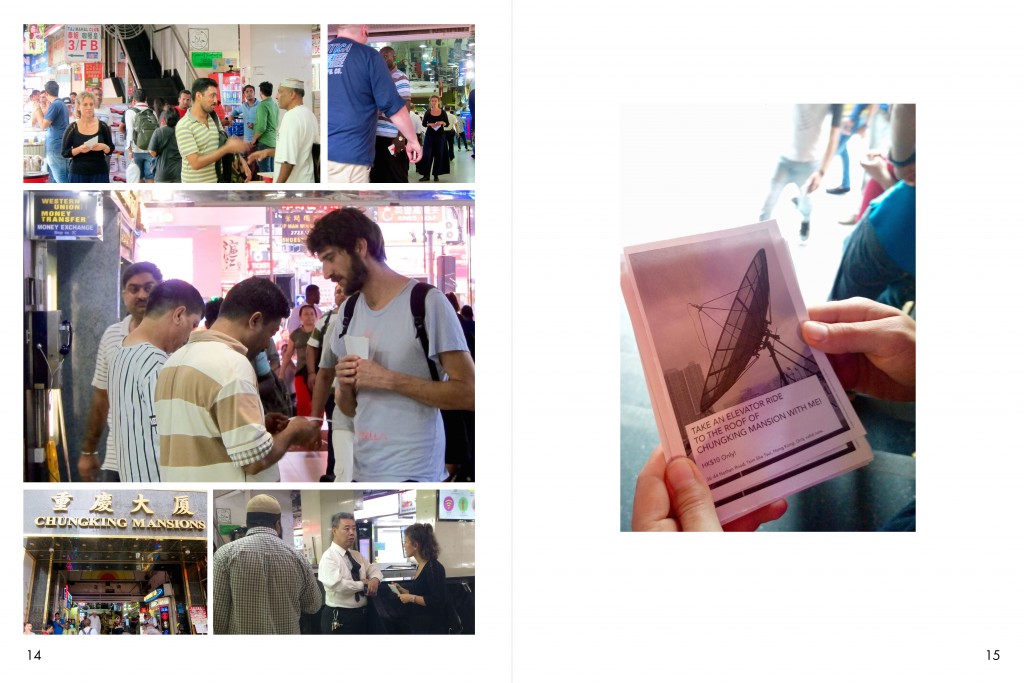

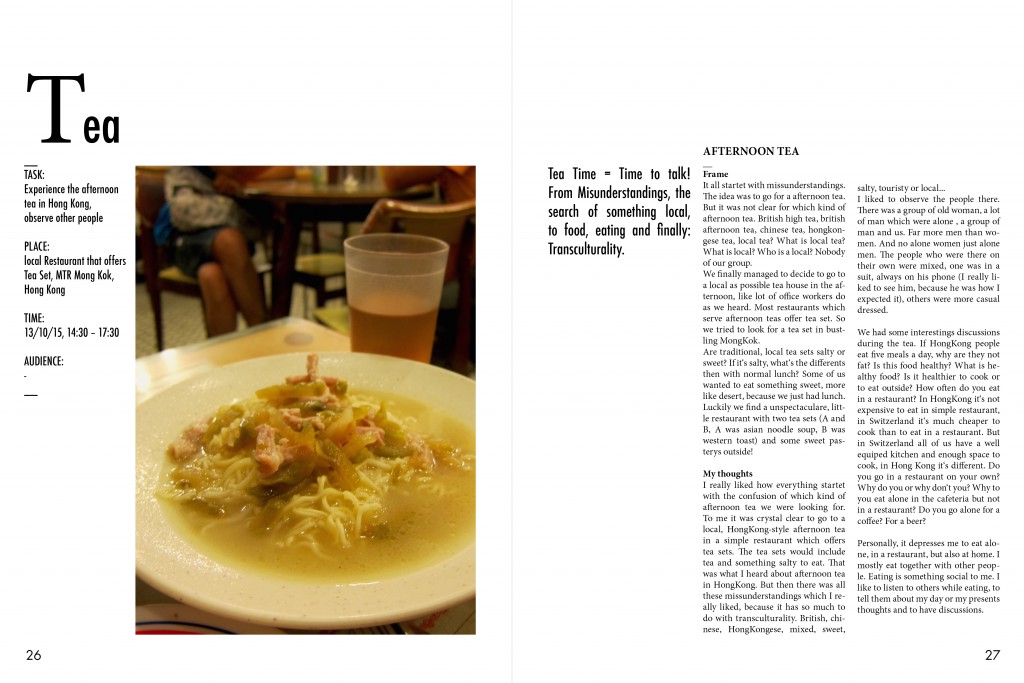
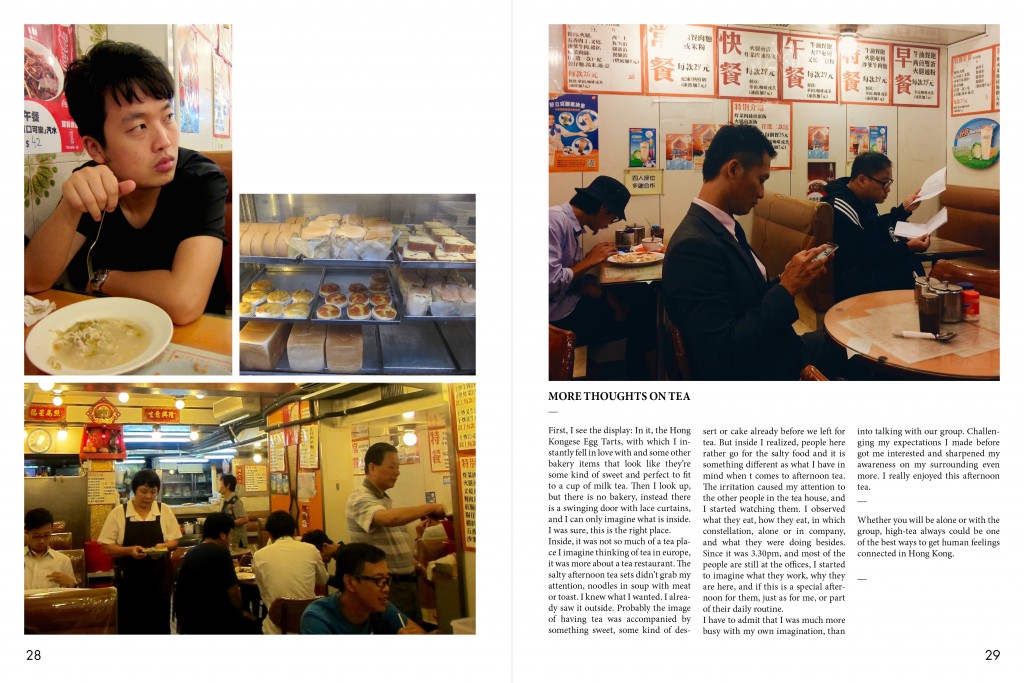
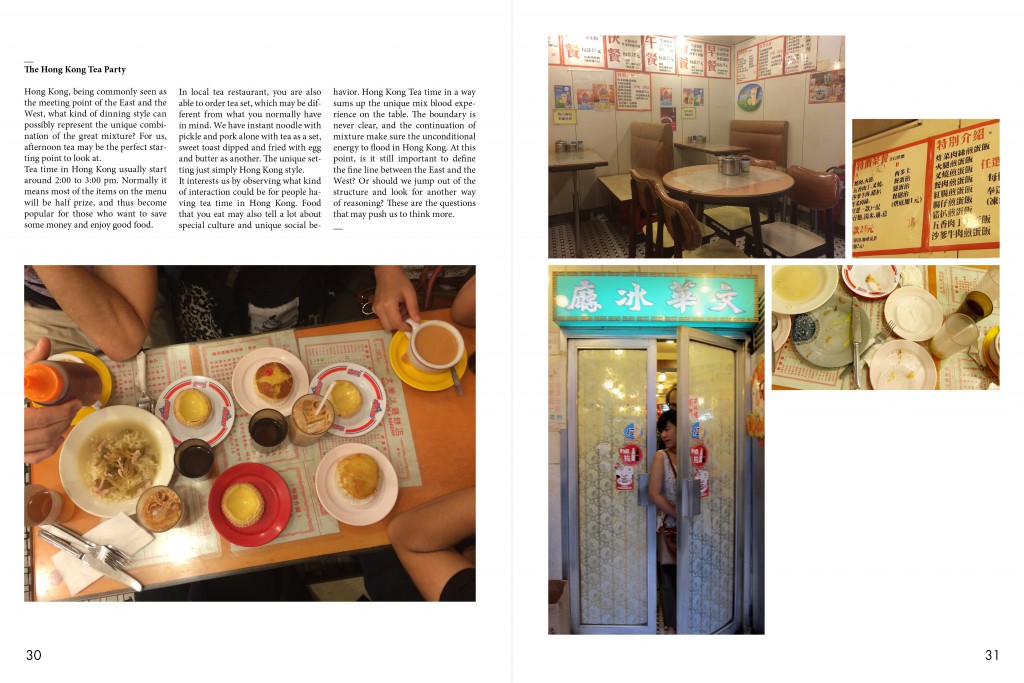
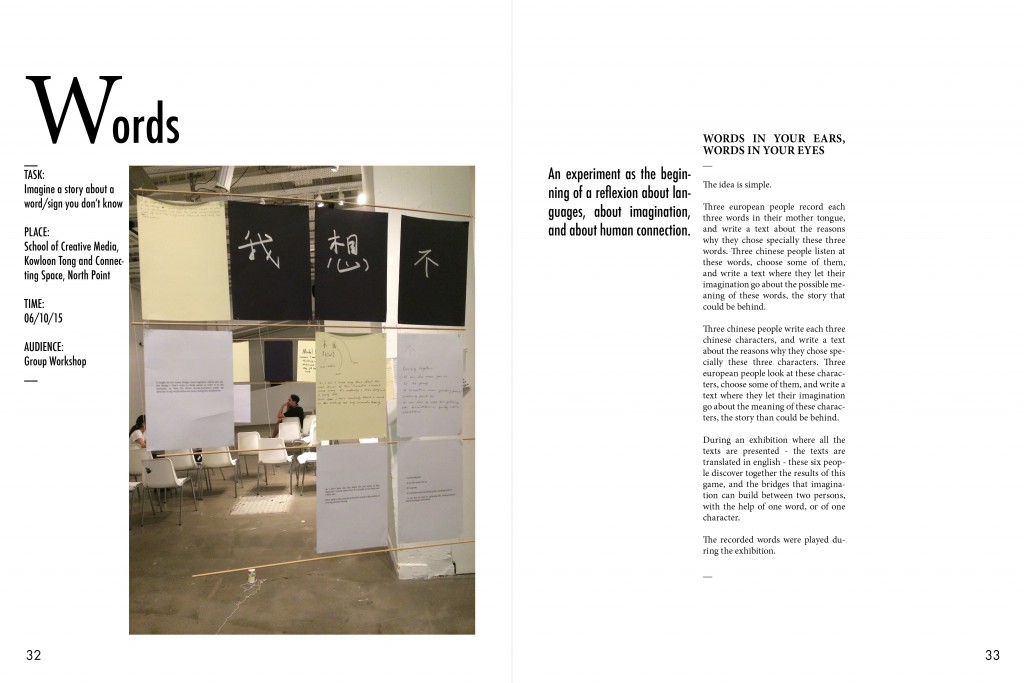
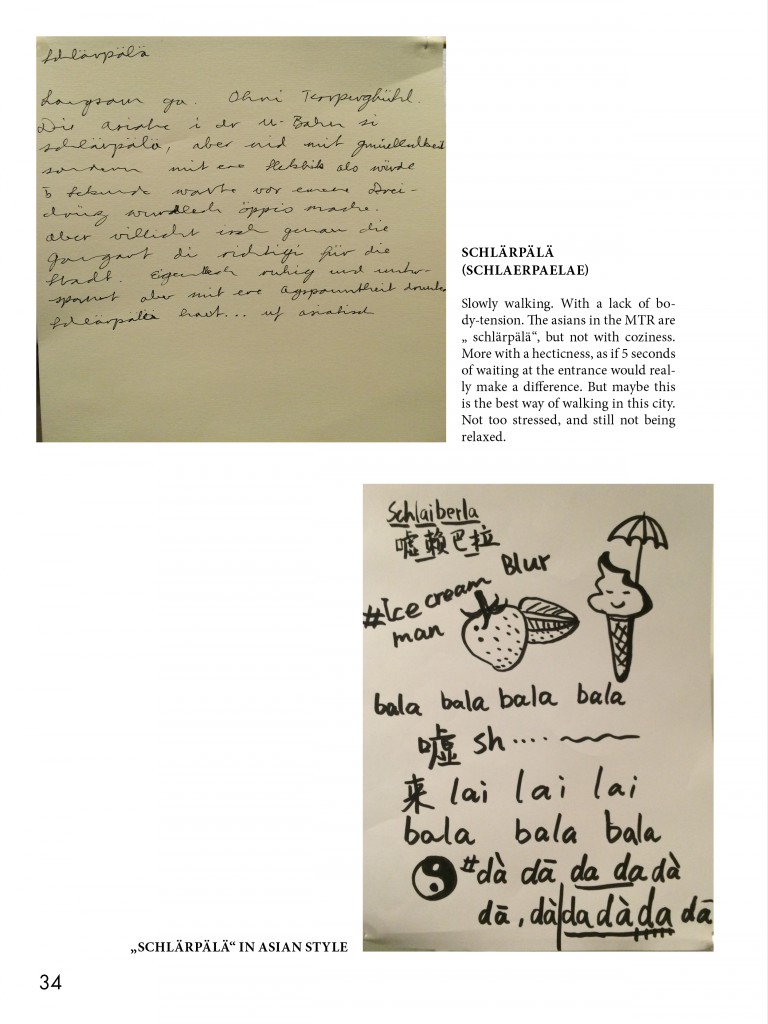
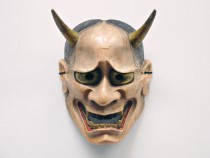
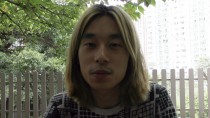
![[ab]sense](https://blog.zhdk.ch/transculturalcollaboration/files/2015/11/Bildschirmfoto-2015-11-04-um-16.52.06-210x118.png)

